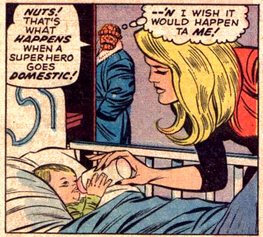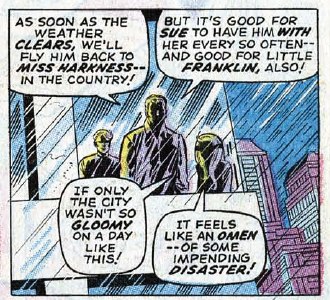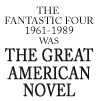







 |
 |
 |
 |
 |
 |
 |
 |


 annual 6
FF81
82
83
84
85
86
87
88
89
90
91
92
93
94
95
96
97
98
99
100
101
102
annual 6
FF81
82
83
84
85
86
87
88
89
90
91
92
93
94
95
96
97
98
99
100
101
102

Summary
The late 1960s were dominated by hope for the future: the summer of
love, widespread opposition to war, student riots, experimenting with
eastern mysticism, and of course the moon landing.
And so it was in the Fantastic Four. We have Johnny's romance with
Crystal (the exotic easterner), the birth of Franklin (symbol of the
future) and mankind finally reaches the moon (without the aid of alien technology!)
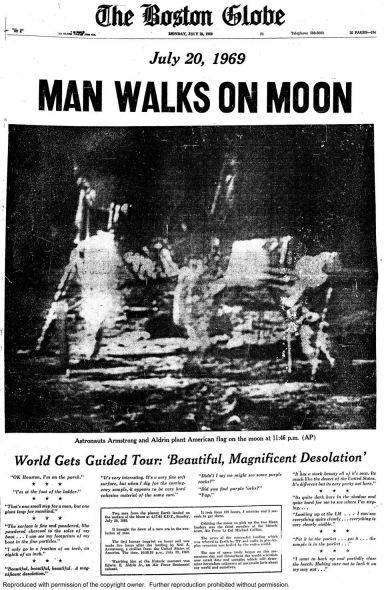 |
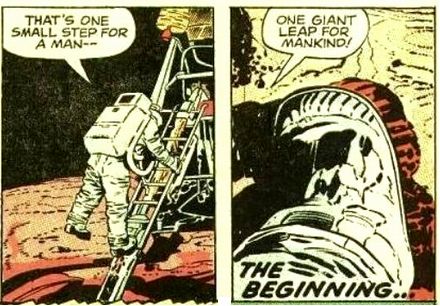 |
Franklin and Kirby
By putting Franklin first Reed could solve all their problems. But
instead Reed continues his old ways, thinking he could do everything
himself. So
this was the end of the happy, carefree period. These are also the
last Jack Kirby issues. Kirby had the skills of a master, but the
creatively of a child, always coming up with new ideas, bursting with
enthusiasm and vision for the future. But this long term view was
rejected in favor of business as usual. So Kirby left and a long term
decline set in: for details see the page on 1968.
Once again this reflects America as a whole: in the 1960s it seemed that a better future would arrive quickly, but the 1970s showed that people are resistant to idealism: this would be a long hard struggle.
This is the big one. The 28 year story is built on Reed not
putting his family first, and that central dilemma, is embodied by
Franklin. Franklin also represent the next generation: the potential of
mankind, and so much more.
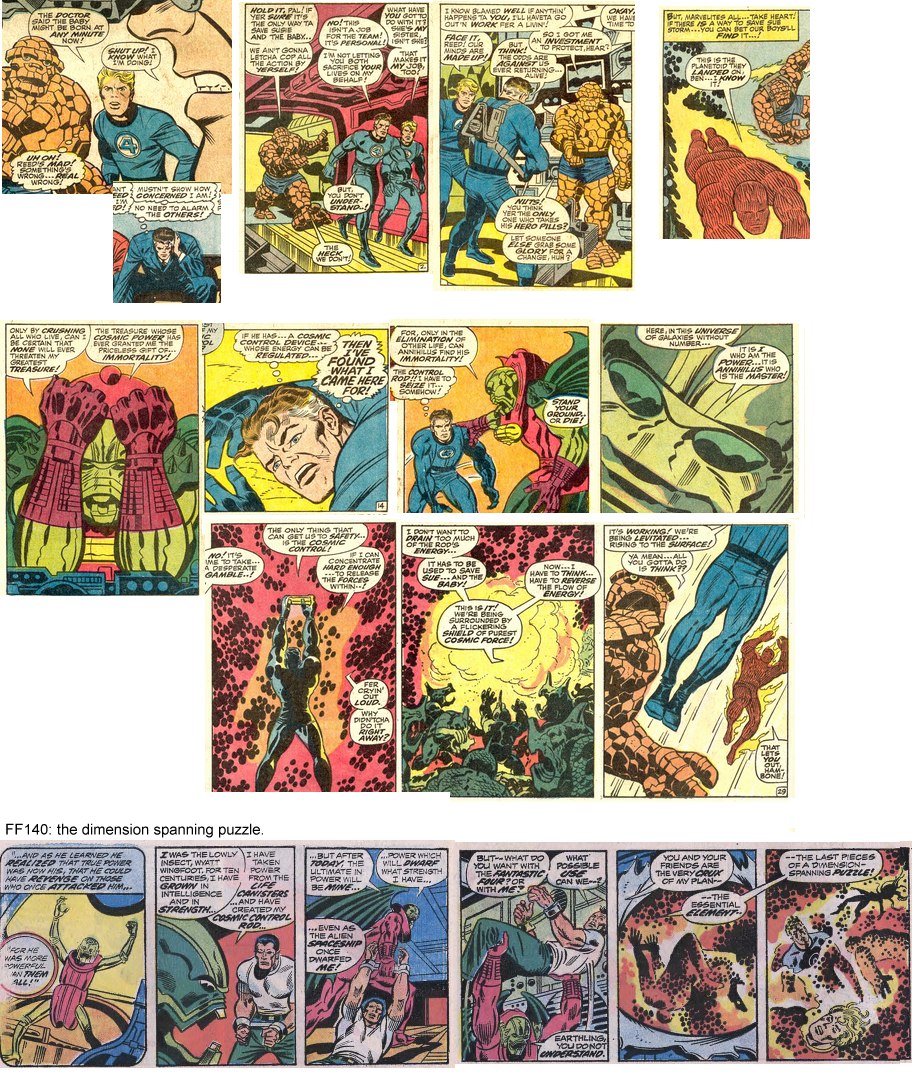
The classic
Karl Disley writes about FF annual 6:
FF140 begins to unravel the secret of Franklin's powers: a
"dimension spanning puzzle" that Annihilus begins to understand.
The cosmic control rod has vast power, gives immortality, and is controlled by thought. Franklin combines this with Reed's physical and mental stretching and Sue's control of energy fields (if 400 is canon then Sue's power has Celestial implications). Together these allow him to dominate galaxies. Galaxies? Really? Do readers have any concept of how big galaxies are? FF Annual 23 explains how scale is all relative and not necessarily the barrier we think it is. The key is knowing how to control external energy, not in having that energy inside your body. Reed's power is all about manipulating and Sue's is all about hiding, revealing and controlling energy fields..
Franklin's power
Franklin gains his power from his parents plus the cosmic control rod. Franklin regulates cosmic power, thus acting as a gateway to alternate realities. For more about his powers, click here.
Drugs again
Note the context:
From this point on
(1968), time for the characters begins
to stretch and do weird things. It gradually becomes clear
that Franklin is behind it all.
Eventually the entire Marvel Universe will merge
with Franklin's private universe and leave reality entirely. And thus the
drugs motif comes full circle.
The historical zeitgeist
This reflects the American zeitgeist. This is 1968, the year
of student rebellions. before the 1960s culture was more focused
on the older generation. Now it's youth culture and everything has
to be young. The child is is taking control.
"By 1968 the team of Lee/Kirby/Sinnott had reached its zenith, moving from one epic to another in the regular monthly Fantastic Four book – it was certainly deserving of its hype as The World’s Greatest Comic Magazine. And then along came the Annual for that year. I’ve read this story 3-4 times; the first time was only 5 years ago or so. But each time I re-read it, the scope of it, the grandeur, the characterization – this was truly a piece of literature that stretched the bounds of comic book fare of its day. The creators really outdid themselves with this issue – in my mind, it’s a story like 'Let There Be… Life!' that really separated The House of Ideas from the Distinguished Competition. The opening scene is just classic Lee/Kirby angst. I am amazed, particularly in reading the FF, how well Stan and Jack worked together. To think that around this time they were not on the best of terms, separated by many miles, and could turn out a scene like the opening 2 ½ pages. Blows my mind how well the pictures and words mesh." - Doug in "Two Girls, A Guy, and Some Comics"Of particular note is Annihilus, and the beautiful ending.
"Franklin’s birth represents the first time (to my knowledge, anyway) that a mainstream comic book couple went through a pregnancy and had a child in anything even remotely resembled 'real time.' Oh, sure, there was Aquaman and Mera, but Aquababy was conceived and born in the space of a single issue! Another example of Marvel’s realistic handling of its characters, which was ground-breaking in the ‘60s." - Sharon, "Two Guys..."
Reed's technology:
Why the negative zone?
Franklin was conceived in FF64-65 (see notes), just after Reed was
trapped in the Negative zone (FF 61-63). That issue draws attention to
FF56, where Reed studied one of the life forms that can survive extreme
conditions: it lives in the area where matter and antimatter collide and
release vast amounts of energy. After that Reed developed an energy
dampening device that came in useful for Blastaar. Now he needs a more
sophisticated energy dampening device, so he needs to go back to the
Negative Zone to find something like the creature, but more advanced.
When he sees the cosmic control rod, he knows that will do the job.
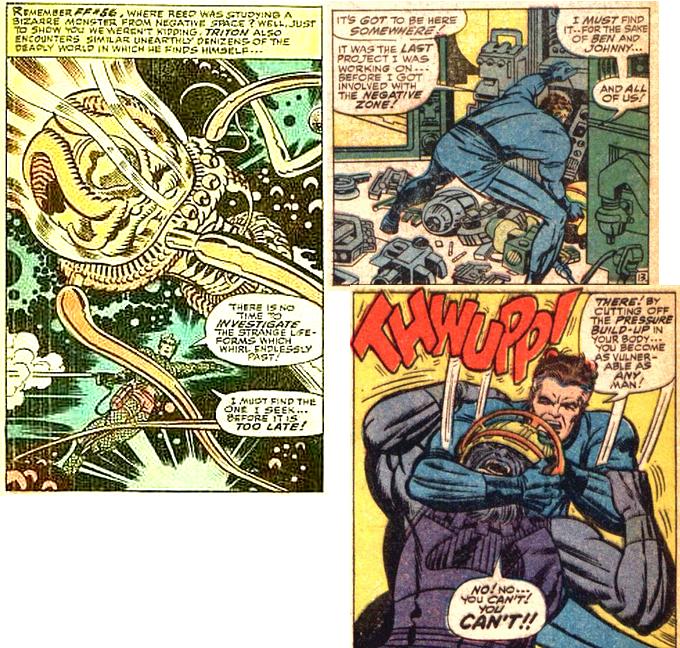
- What is the exact danger?
Why is the radiation dangerous? Radiation in the blood is nearly always dangerous. This is just realism.
- The Scavenger
Why does the scavenger instantly find Reed? Isn't it a bit unlikely that Annihilus would instantly find Reed, a man he does not know, even before Reed had fully left the distortion zone? FF183 reveals that this was built from the Thinker's android that Reed tossed into the negative zone: it was designed to home in on Reed.
Please remember that this web site is pro-Reed Richards. He is perhaps the greatest human hero who ever lived. He saved the world more than a dozen times. This makes his story a Shakespearean tragedy: the great hero brought low by being unable to understand others.
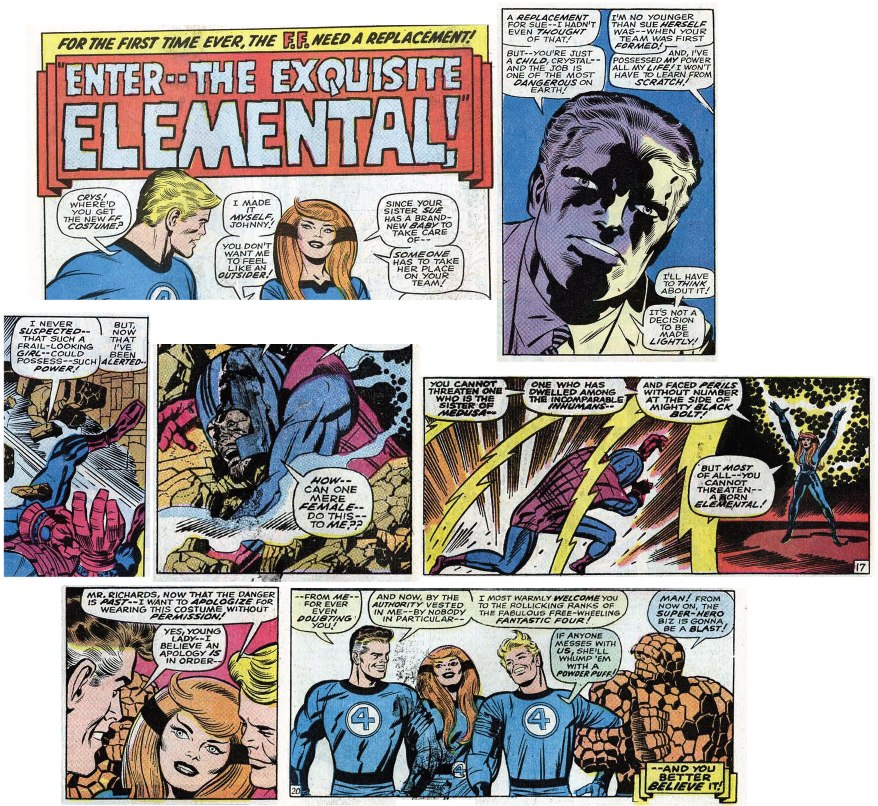
This issue is the antidote to those who assume that Reed is
sexist. Reed is not sexist: there is no evidence that he considers
women to be weaker than men. (See the notes to annual 2 for more on this topic.)
Certainly he believes they have
weaknesses unique to their gender, but he also believes they have
unique strengths. Reed does not single Sue out to undermine her:
he also infantalizes Ben. This is not sexism, he simply cannot
stand a threat to his position as the smartest and the natural
leader. Crystal is no threat to him so he welcomes her power as an
asset to the team.
"Throughout the adventure, it
is actually Reed who is most supportive of Crystal, which is odd
because he has shown himself to be the most anti-feminist: the
first always to tell Sue to stop acting emotionally, to keep
information from her, and to exclude her from the team. But not
so with Crystal, who Reed compliments as a strategist before
telling Johnny that she doesn’t need his help. In fact, Johnny
exposes both himself and Crystal to danger by being overly
conscientious of her, staying to help her out of the
Fantasti-car and taking a hit from the Wizard for his troubles."
(source)
Note that Crystal and Johnny are social equals, and Johnny does feel threatened. Johnny
is immature and sexist (remember the times when he sits down and
lets the women serve him), and that is why
he will lose Crystal. That will force him to grow up before
he is worthy of her. threatened by reflecting an era when women
were treated as inferior, but that is to miss the point: Sue is a
threat to Reed's ego. Crystal is not. Crystal spent a year being
subservient, and nobody could ever imagine that she has a claim to
lead the team, so Reed is perfectly happy and supportive
Other points to note:
The Wonder gloves have "the combined powers of the FF". The point is always that super powers are not the answer, because you will always find others more powerful. The real answer is to make friends: the Wonder Gloves were beaten because the team welcomed a new member.
Blond Sue was replaced by red headed Crystal. "A blond being replaced by a redhead merely set a precedent for later Marvels (arachnids anyone?)." (Robert Papetti, "Fantastic Four In The Silver Age Sixties: A Tribute")
This issue is criticized (here) because the Wizard is alleged to have no motive. Au contrare. The Wizard has the most fundamental motive of all: he wants to prove he is better than others. He serves as a comparison with Reed, and a contrast with Crystal who is a natural team player. The Wizard never had success with his foursome because his ego is even bigger than Reed'
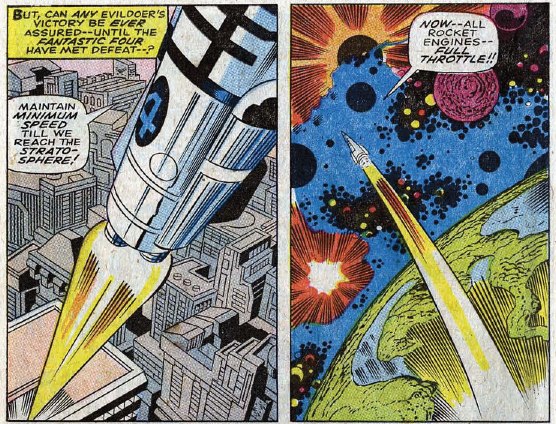
This is the issue where the Americans finally fight alongside the
Asians in the Asians' own land. The parallel with Korea and
Vietnam is obvious. Although Medusa and Gorgon suggest Greek
roots, Greek culture spread via Alexander the Great to Asia. The
Inhumans' location, the stopping off in Tibet, the family values,
Karnak's power, etc., all place the Inhumans as Asian. Note that
they appear in 1965: just 20 years earlier the Japanese were
condemned as inhuman in wartime propaganda, and since then Asian
leaders (Russia and China) was the great inhuman despots in cold
war propaganda.
The Great American Novel, reflects the individualism of the west.
The Inhumans, coming from the Himalayas, provide the contrast of
Asian values. Crystal comes from a monarchy and is used to a rigid
class system: this is made clear when her first act is to ask
permission from her people to join the FF. The rigid patriarchy is
made literally transparent when we see Maximus imprison all the
male royalty in a glass box: he does not ant their defeat or
death, he wants their humiliation. Control is everything to
Maximus: most of his intellect is focused on hypnotic control of
some sort. Once again we have a parallel with Reed's need to
control. This theme is repeated again and again over the years
because it is America's great challenge: how can you rule, except
by force? Comics, like Hollywood, present the answer: soft power.
A global love of American culture is more powerful than any
armies.
Hayek and Capitalism versus
socialism
The title, the "Mark of a Madman" applies to Maximus;' desire to
control everything. Micromanaging is inefficient and therefore
irrational. This is the underlying economic fact of the cold war.
As pointed out by the free market economist Friedrich
Hayek, planned economies are fundamentally weak because it
is simply impossible to control everything. Note that the
Inhumans, though physically miraculous and technologically highly
advanced, have never been able to expand beyond a single city and
are riven with endless internal conflict. This can easily be
traced to their strict class system where one person decides
everything, and those with royal blood (like Maximus) get a free
pass to do what they want. Arguably Black Bolt's greatest strength
as a leader is his silence: it makes him unable to micromanage
everything (he is too proud to use a technological fix).
Other points to note
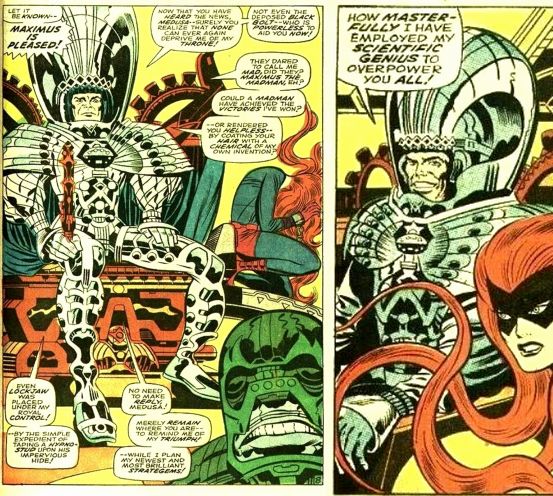
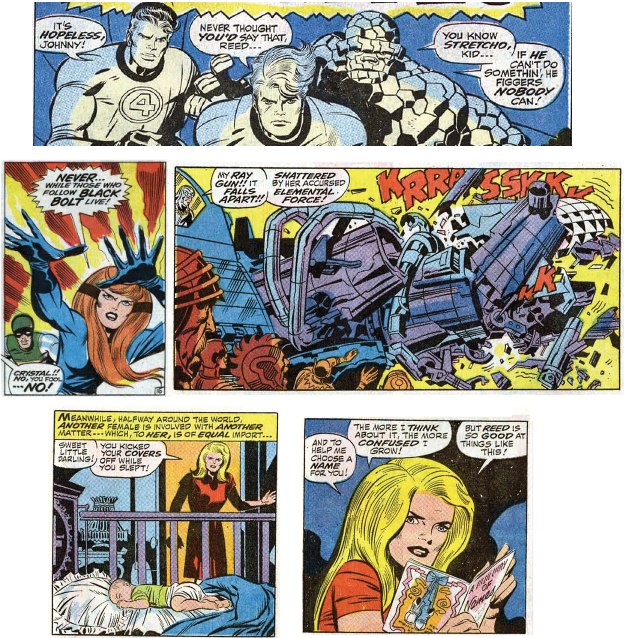
Critics see Sue as ineffective here, but look more closely: The
men are just as ineffectual: the Inhumans' problem is solved by
the Inhumans themselves) whereas Sue knows instinctively that
bonding with her son is the most important thing she can do. Her
son is master of the universe, and if only they would focus on him
then all their problems would be solved. This is the ultimate
family value: children are what matter. The men may go off on
their adventures to distant lands but those are ultimately
irrelevant. What matters is at home in the cradle.
This is Sue's first appearance after the pregnancy, and she's wondering what to call their son. This contrasts with Reed, who cannot even be bothered with that simplest task for more than a year! Reed and Sue's priorities were never more stark. Reed's lack of concern for the family will eventually cause Sue to leave, and serve Reed with divorce papers (FF147).
Phallic symbolism
Note the symbolism of Maximus' great phallus shaped gun (note the
bulbous tip, the tubes leading to it, where Maximus sits...). This
is destroyed by the girl: her ability to work with nature defeat
his science and his hypnotic need to control nature. Heck, even
his name, Maximus, is phallic. This contrasts with what appears to
be Sue's weakest moment (confusion over a name) but it's actually
her strongest (intuitively knowing that her bond with Franklin is
more important than anything the boys might be doing).
Foreshadowing the turning point
This issue, about the girls treated as the weakest yet being the
strongest, foreshadows the similar story in FF159. That issue
features the "Thunder Horn" where again Sue is treated as weak.
but it's the last straw: she saves the day in a dramatic fashion
and that marks the half way point in the 28 year story. From that
point on, Sue is quietly in control (see comments to FF159).
The topic of hard power versus soft power brings us to chess. Chess
is the usual metaphor for power on the national stage, because a wise
king tries to outmaneuver his enemies rather than wasting his resources
on direct conflict. Maximus could not defeat Black Bolt in direct
conflict, but outmaneuvered him. Which brings us to that cover image:
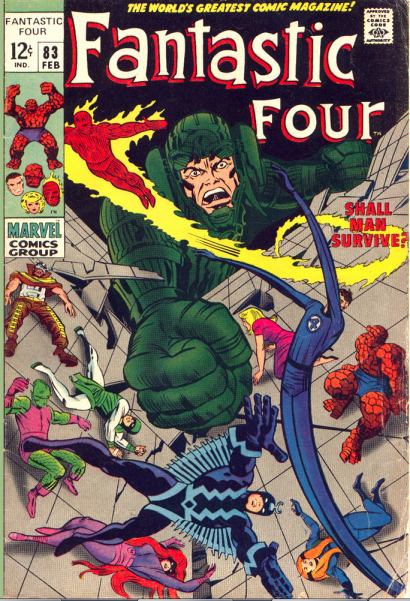
The cover to issue 83 is very interesting. It makes no sense as a normal Kirby cover: there is nothing real about it, and the figures are very stiff. "the static figures and bad foreshortening make me think this one may have been rushed." (- Paul Benincasa) Perhaps it was rushed. But the stiffness reflects the story inside, where the characters are powerless. Look at the checkerboard pattern: the characters are like pieces on a chess board, controlled by Maximus. Perhaps this some other kind of board game, but the story is all about Maximus treating people like pawns.
It's a beautiful and powerful image. Maximus' size and weirdly
extended arm reminds us that when you're around Maximus nothing is as it
seems. A close look at Maximus' power shows his only real power is to
manipulate minds, which in his case he uses in conjunction with his
royal position. He wants to be the king on this chess board. Actually,
chess is a fertile metaphor for the Inhumans:
The very next issue takes is to the greatest chess player of all: Dr Doom
Doom and Maximus compared
There are two examples of bad rulers in the FF: Doom and Maximus. They
are both chess players in their own way, but Maximus uses deception
whereas Doom uses his formal position. They symbolize the two kinds of
political power in the world: power through maximizing one's image
(Maximus) and the more overtly dangerous power to command others (Doom).
As Maximus works through deception, he is never seen actually playing chess. He is only ever seen in two states:
In contrast, Doom represents power through using his formal position. He has no reason to smile or care what people think (or so he tells himself): he hides his face and uses his power openly and coldly. They are both chess players, they are both geniuses who control those they consider beneath them, but in different ways.
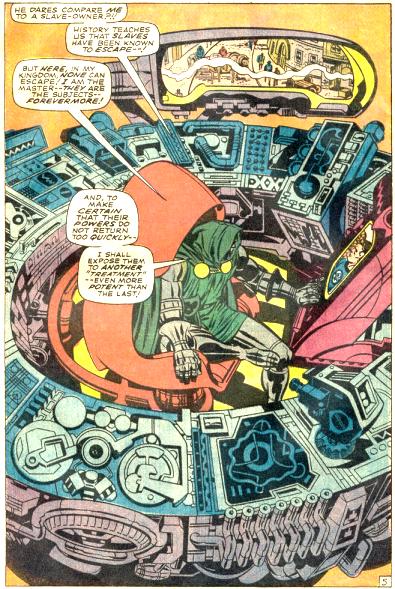
And what happened to Maximus? He fled at the end of FF83, and was
next seen in Hulk 119, in Central America, using Doom's new trick:
advanced robots. Maximus' next appearance is in Silver Surfer
18. The surfer had just battled SHIELD and crashed into the Hidden
land. Maximus tries to trick the Surfer, just as Doom does when the
surfer visits Latveria in FF155-157. The Surfer is next seen in Central
America (Sub-Mariner 34). At around the same time Crystal was
brainwashed in Central America by Diablo (FF118). The repeated stories
about Central America and mind control reflect American involvement in
the region, which the public were beginning to suspect it was not always
benign. In all this era we see Central America (representing American
foreign policy), the surfer (representing idealism),
SHIELD (representing the CIA), Doom (representing calculating rulers)
and Maximus (representing those who influence our minds in the pursuit
of power). It's all the same story: the Great American Novel is delving
in international politics: a grand game of chess, where Doom and Maximus
are the main players.
That next story begins with Nick Fury, reminding us of the recent Nick Fury-Doctor Doom story where Doom plays chess. (That was the classic Strange Tales 167, cover dated April 1968, the final story arc before Agent of Shield 1)
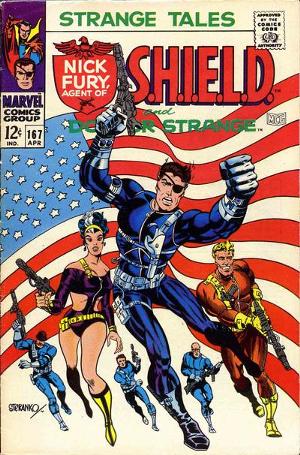
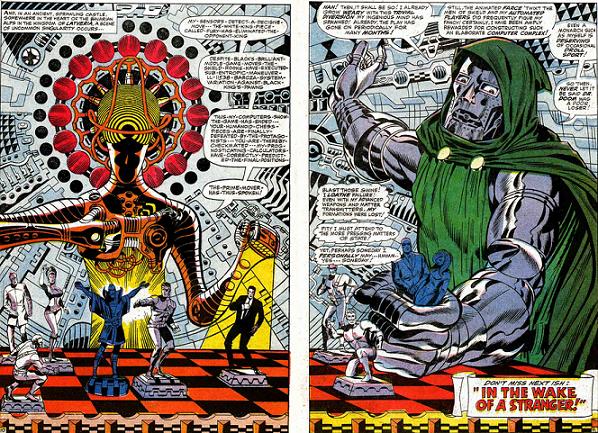
Doom sees everyone as pawns, as we see later in the longest FF story of all, the half way story in the Great American novel (FF155-157):
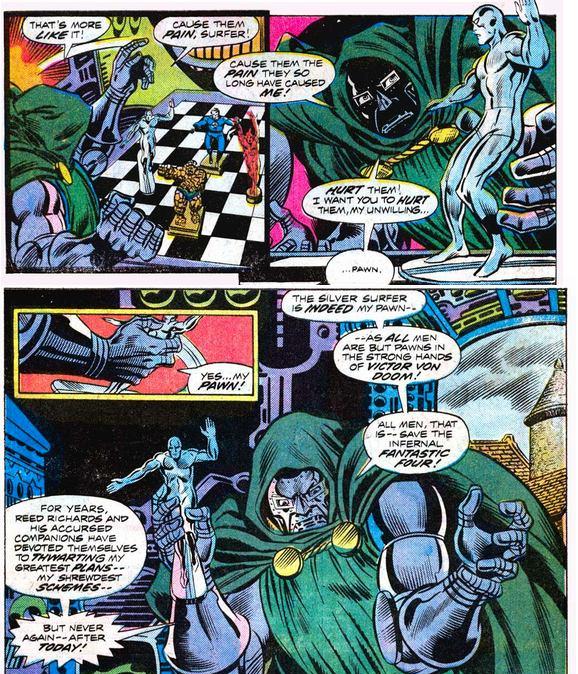
Which brings us back to the Inhumans again. At the end in act 5 (in annual 21)Doom's game of chess is against Kristof, and his plotting involves the Inhumans once again.
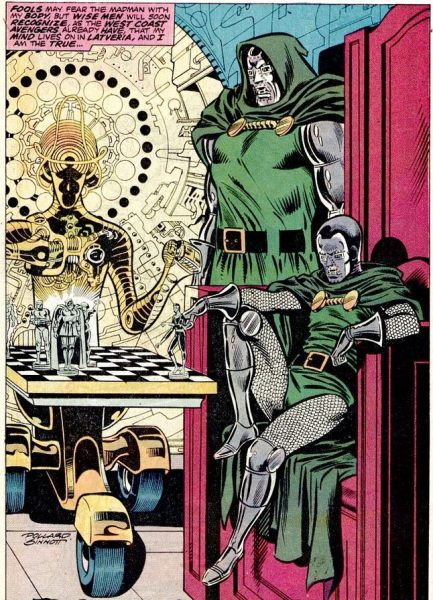
So it's time to return to Doom:
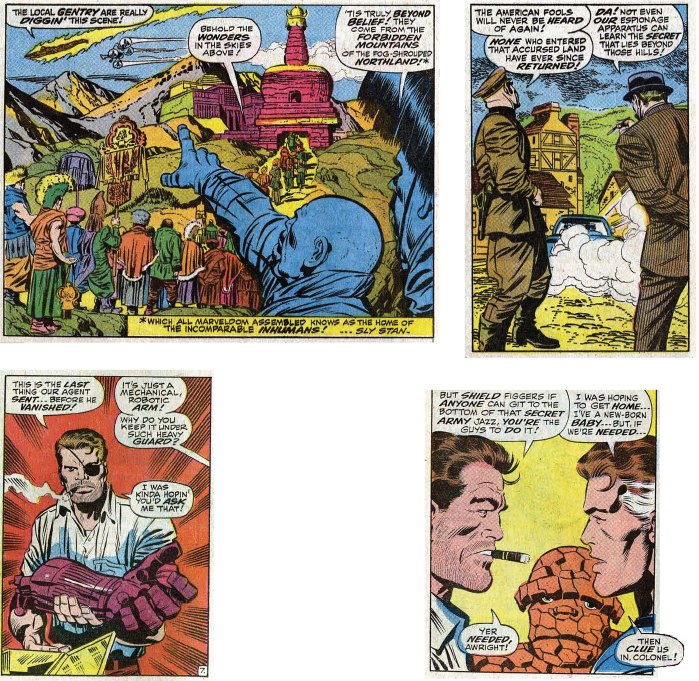
The big Fantastic Four story is about love. Sue shows love by submitting to Reed's requests (a policy she finally abandons when Reed proves unworthy of that love in Act 4). Reed shows his love by leading Sue. But is that really love? This issue gives a hint:
“Have I not told you how dearly I
love my subjects? Do you think I would allow a single one to leave
this realm?” -
Victor Von Doom
Controlling other is not love, no matter what the good
intentions. Controlling means you treat everybody like robots,
hence the symbolism of this issue.
The genealogy of robots:
Appropriately for a story about controlling others (Reed's
problem) and sense of identity (Ben's problem), the Fantastic Four
features a number of robots. The story shows their origins and
development over the years. Before this point the Thinker
developed increasingly sophisticated androids (most recently in
FF79), and it is likely that some fell into the hands of Doom, and
the robot in FF80 was one of his.
Doom's robot development can be traced step by step over the
years, and like Reed he makes the best use of whatever technology
he can get his hands on. In his earliest days he merely animated
simple tools using crude demonic possession learned from his
mother (see commentary to
annual 2). Doom gained advanced technology from the Ovoids
in FF10, but Ovoids relied on direct mental control so their
robots still had very little artificial intelligence: just a year
before this (in FF73) Sue could be sure that Doom was in Latveria
simply because she saw him there on the TV news. But in this issue
Doom creates more advanced robots, probably based on the Thinker's
tech, and soon after this we see him use robot doubles: Doombots.
Doom's robots do not markedly improve after this. They may be
refined in various ways, but are not as smart as he likes to
pretend (see the backup story to FF358).
Where did the Thinker get his androids? His greatest creation was
the Awesome Android, and all later androids were merely tinkering
with that basic potential. He got this idea from Reed's notes on
unstable molecules. The great breakthrough seems to be to stop
thinking of a robot as a machine that is made to appear living,
but instead to start with some form of unstable molecules and make
them act like a robot. For where Reed got his unstable molecules,
click here. For how the
molecules work, click here.
Other points to note:
The Great American Novel
This is the American dream - to travel further, be braver,
and discover exotic lands. it also contrasts modern America
with the old countries of Europe.
Art
This is beautiful art. "Latveria and Eastern Europe are very
compellingly portrayed by Kirby. It undoubtedly springs from
Kirby’s memories of being an infantryman in the first world
war. " (source)
Doom's character development
For an overview of Doom's development in his twenty appearances see his own page.

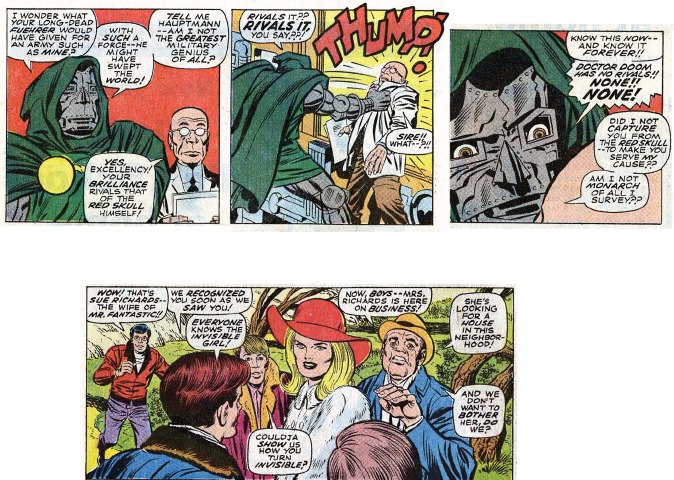
The Great American Novel is ultimately about family, and this
issue is about the physical home. Sue searches for a new home
where they can raise Franklin: she must realize that Reed made a
big mistake in coming back in FF72, but her way is not to cause
confrontation so whenever says so. She just knows intuitively that
the team will be at its strongest when Reed puts his child first.
The same principle is taught using Dr Doom: When Doom focuses on his homeland then he always succeeds, but when he neglects his people he fails. This arc is about Doom: The Great American Novel is six thousand pages long simply because it deals in depth with many characters and subplots, and each subplot has its own beginning, middle and end: some take 28 years to tell. We watch each character grow and change over the years, we see their triumphs and failures, and how they contrast with the core team. Dr Doom is a classic example: he grows and changes over the years and finally achieves peace.
This issue begins Doom's finest hour, where he achieves nobility.
As with "nobility" throughout history, the word has two meanings:
higher values (refined tastes, and the ability to rise above a
situation as Doom does at the end of this arc) and social
inequality that produces the grossest evils. Throughout history
the nobility has often been anything but noble.
A tour of world cultures
With Crystal on board, the team expands its horizons. We focus on
the globe as a whole rather than the individuals in the Baxter
Building. The Crystal issues are a tour of the cultures that
affect American culture and politics:
FF82-83 is Asia
FF84-87 is old Europe. The hypocrisy of the class system reflects
the old Europe that the Great American Novel rejects.
FF88-89 is the white underclass (see commentary to FF89)
FF90-93 is slavery and oppression of different races
This is not a condemnation of America: in every case the elite
Americans (the Fantastic Four) are the heroes, and show
compassion. But it's tough at the top, and they often make
mistakes without realizing it. Just as in FF84 where Reed barges
into Latveria and is of course captured. In contrast, Sue in FF86
is able to quietly slip into Latveria undetected.
Criticisms (source) for
"What proves ultimately
frustrating is that although 10 out of the issue’s 21 pages are
dedicated to Doom, almost nothing significant is revealed about
his character. He just marches around, barking orders at people
and insulting them. It’s nothing that couldn’t have been
conveyed adequately in a quarter of the space." This may be an
example of not seeing the forest for the trees. This is the
definitive story in developing Doom's character. He began as an
angry young man with some basic skill at demonic possession and
very limited access to discarded alien technology. In FF10 he
gained far greater tech, and in annual 2 he managed to gain a
position in a tiny European nation. But still around that
time he acted as an amateur. This is the story where he learns how
to be a statesman, publicly molding an entire nation into
his image. The question of why he wants to control and humble Reed
rather than kill him is answered in the
notes to FF17.
The zeitgeist
Many commentators have noted close parallels with the popular
1967-68 TV series The Prisoner, starring Patrick McGoohan. But
this story goes much further. "Some
readers compared the layouts of Doom’s view screens and central
command chair to a TV series called The Prisoner. But to me, the
FF defending the helpless village against marauding invaders –
Doombots – on a quaint European stage was a World War II scene
out of Combat. Likewise, the FF storming the castle in the
finale was more exciting than trying to take back their own
building in the big city." (Robert Papetti, "Fantastic
Four In The Silver Age Sixties: A Tribute")
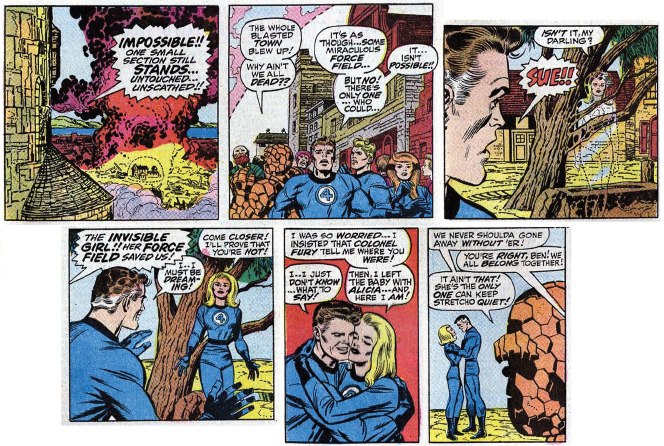
In this issue the team's greatest defeat becomes their greatest triumph because of their most powerful member - Sue
The importance of this event cannot be overestimated: it's Sue's
turning point. This is the first time she directly disobeys Reed
in a major way. She is beginning to realize that obeying Reed is
not always best, and if they all did things Reed's way they would
all be dead. This undercurrent develops over the following year,
and finally bubbles to the surface when Reed visibly and
consistently fails. Reed will seem to be humbled in the early part
of act 4, when Sue finally leaves, but when she comes back there
is another event like this one in FF86: a similar disobedience
saves the team in the Thunderhorn story (a phallic symbol of male
ego). Reed's complete and genuine humility will take a lot longer
to achieve.
Criticisms
This plot has been criticized because Doom keeps talking about
the robots' Achilles heel and then left technology for Reed to
find. But that is the whole point!
Doom does not want to kill the team, he wants to make them look
stupid. The irony is that in the end, after all of Doom's
planning, it is he who looks stupid, because this master of
control is unable to control even his most loyal follower.
Please remember that this web site is pro-Reed Richards. He saved the world more than a dozen times. This makes his story a Shakespearean tragedy: the great hero brought low by understandable pride.
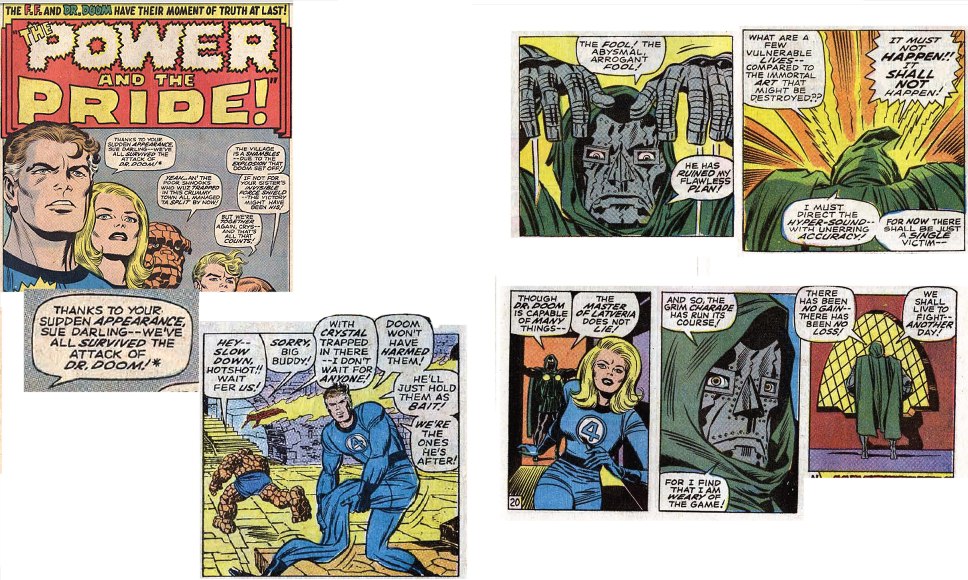
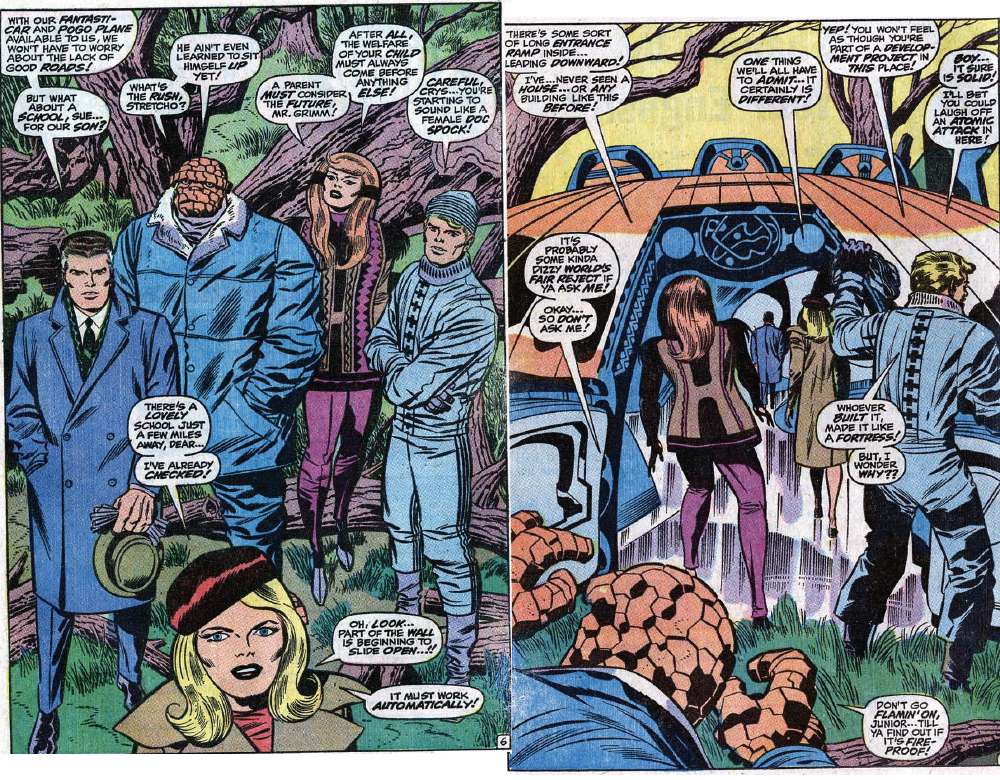
FF88 is the turning point. It's the start of "the hero's journey"
(see Joseph Campbell's classic study of mythic structure, "The
Hero With A Thousand Faces.") This is where they cross the
threshold, they leave the superhero focus and begin the family
focus. From here we see them in civilian clothes more and more.
And this is where it all starts to go really wrong, because Reed
rejects his new role: in FF94 he sands his son away to a nanny.
Observant readers may say "wait a minute, I thought that FF72 was
supposed to be the turning point, when Reed left to focus on the
family, and turned round? Yes, and here we see Sue at her finest:
guiding Reed back to where he was supposed to be, without him
realizing. Whereas Reed took an express train without any thought
of where he was going, Sue prepares a house first sand gently
eases the family into it. True, the first house doesn't work out,
but that's normal, most young couples have to try several houses
before they find one they like. But Reed cuts that process dead
when he sends Franklin off to a nanny instead. Sue will then
realize that the situation is even worse than she thinks. She will
gradually begin to take a more forceful role, even leaving reed at
one point. But gradually she will guide Reed to where he needs to
be, and in FF304 he will try again, and next time it will take a
bit longer before he gives up. Sue will take as long as it takes,
but she will get her family where it needs to be. Sue will win
eventually, invisibly, because she is the most powerful member of
the Fantastic Four.
This is more than a comic
Time and again the Fantastic Four is dismissed because people assume it is just a comic and do not look any deeper (even though the title at the top of every cover is "world's greatest comic magazine" - that should be a clue). This issue is a classic example of that. E.g. Mark Alexander in "Lee & Kirby: The Wonder Years" criticizes Kirby for wasting space on two consecutive full page images, just to enter a doorway. To Alexander it's just a comic and therefore these images cannot possibly have significance beyond the issue in question. But when we stand back and see the bigger story it is so much more. Which is not to say that it only works at the deep level. The Fantastic Four works on every level: if you just want simple battles then you get that. Or if you just want amazing images you get that too: many critics who treat the issues as unconnected will still praise the entering the house image because the sixties fashions and architecture are so beautiful.
Crossing the threshold
This crossing off the threshold is rich in symbolism:
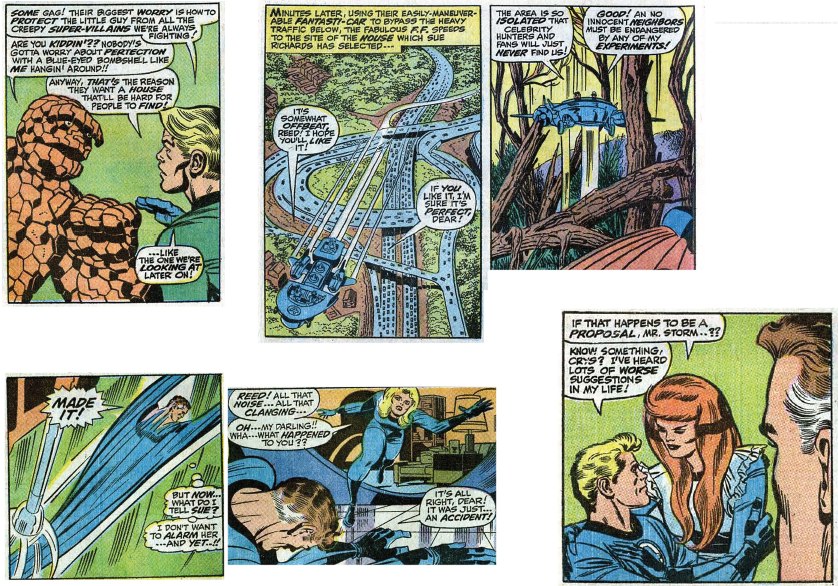
The Mole Man in context
For how the Mole Man's ten appearances reflect racism and the underground in America, see the notes to issue 1.

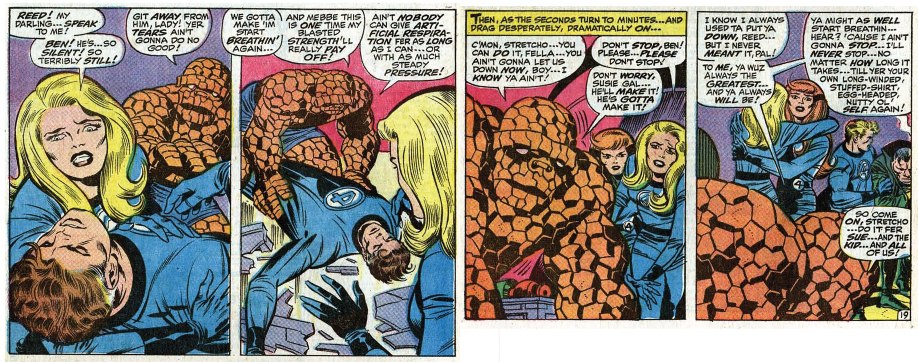
This issue is not about fighting, it's about blindness. Reed is
blind to those he sees as below him: he is blind to Sue's needs
(that he should put Franklin first), he is blind to Ben's needs
(considering Ben to be childish), he is blind to Johnny's needs
(he always takes it for granted that Johnny must stay forever in a
a junior role:he can never leave home and start a family of his
own). What better metaphor than the Mole Man? Note how the team
stumbles over themselves - we might expect them to adapt, but it
is important to the metaphor to show how badly they cope when they
cannot see what is in front of them.
It's not just a metaphor. The Mole Man is almost blind, and unlike Alicia he is ugly, so people will not let him get close so he can understand in other ways as she does. So his blindness directly leads to his prejudice. Similarly, this is the first time the team have felt sympathy for him. They had to be blind in order to begin to understand that what they see as aggression and whining manipulation is just fear.
Note that Reed's blindness leads to his "death." (Specifically it was his blind firing of the Mole Man's staff: Freud would understand perfectly.) On one level this is a reminder of how much the team love each other, but as a metaphor it harks back to the cover of FF61:
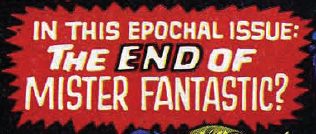
FF61, you will recall, is where Mr
Fantastic ceased to be fantastic.
We cannot discuss blindness without discussing Alicia
Ironically the one who sees best is blind Alicia. She isn't in
this issue because she could so easily win that the danger would
be over too quickly. But Alicia is the one who sees the emotional
truth better than anyone even better than Sue. Alicia is the one
who saved the world from Galactus, by showing the Surfer a better
way. Alicia is the one who always tells Ben that he is handsome
regardless of his skin color. Alicia is the one who will always
have time for Franklin, even when Sue is too blind to see her own
priorities. This will come to a head in FF251, which will lead
Alicia to take action that will finally cause the happy ending
that nobody else can achieve: Alicia is often accused of being
passive, but when she leaves Ben for Johnny she forces Ben to
finally take responsibility for his life. This in turn forces Reed
to finally see the truth of how his actions have affected Ben over
the years. And marrying Johnny will finally force Johnny to become
emotionally mature, and ready for the return of Crystal. Crystal's
return will break Alicia's heart of course, but the strongest
women have always suffered for their quiet work and are almost
never recognized. It is precisely their ability to work without
recognition that makes them so strong, as they avoid the
disastrous ego that brings the men down.
The zeitgeist: the
disenfranchised
This issue is written in 1968, the year of assassinations and
student revolts. It's a time when the younger generation are
accusing the American authorities of ignoring the weak and
marginalized. In this context look again at the Mole Man, the
little ugly guy with his complaining and his personal weakness,
with his countless millions of weak, forgotten people, always
under our feet, always resenting and plotting. The Mole Man's
people parallel the American elite's fear of the poor and
marginalized who might one day rise up. No worker's union was ever
as united as those Moloids, endlessly building things.
"Luckily, one of Reed’s blind shots at the wall restores
everyone’s sight (yeah…)" This was not luck. In the previous issue
Reed examined the house, and while blind he had time to think
about how the house worked. We are told that the house was a
gigantic computer, so disrupting one part would disrupt it all. We
are also told that the rays were designed to engulf the whole
world, so we are not looking for some tiny device hidden in one
wall: the entire house is the device. That would explain the
strange shapes in its design. Destroying any sufficiently large
part of it would disable its entire function. This also explains
why it is in such a remote area: it's vulnerable so did not want
to be found. But the Mole Man didn't anticipate the fame of the
Fantastic Four: the local land owner would of course see it, and
think of the FF as the natural buyers.
Other points to note
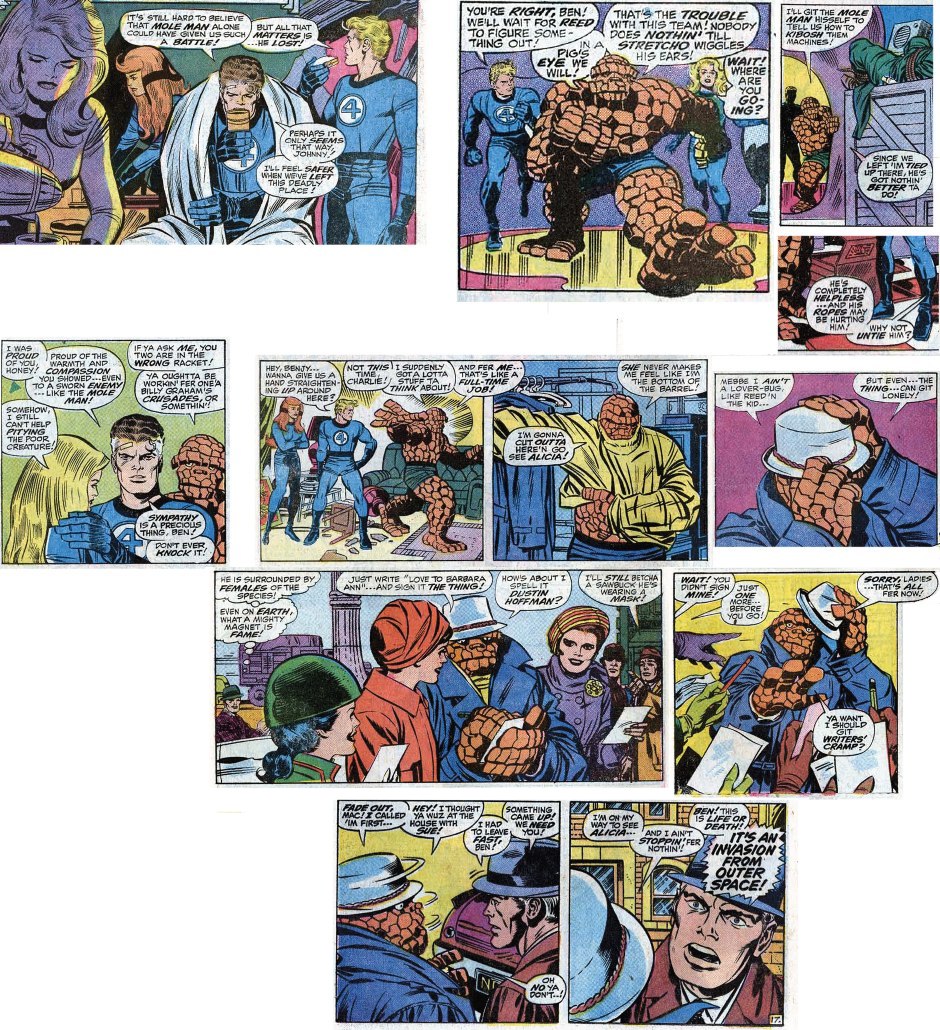
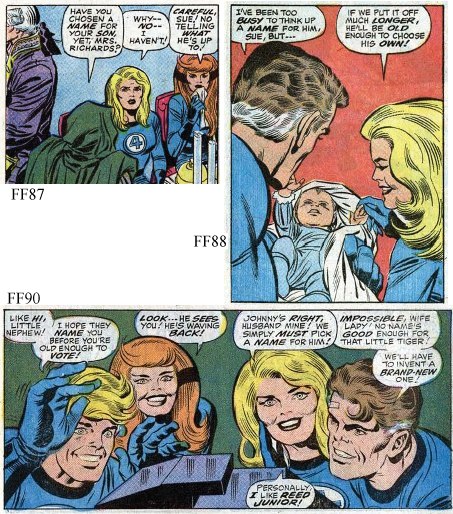
"Reed says that there’s no law against trying to take over the world, but there is against assault, of which the Mole Man is guilty of at least five counts." However, they invaded his house and damaged it, so it was self defense. More seriously, the Mole Man has untold millions of followers ready to cause WWIII if he's detained above: no court would touch that for something as simple as hitting a trespasser, and Reed knows it.
"It doesn’t make sense for Ben to immediately cut out after the Mole Man vanishes" I disagree. he leaves because he is angry at how everything centers around Reed, and this is the point of the story. Ben would not feel comfortable there anyway: The Mole Man is a painful reminder to Ben of how he became a monster (see FF126, FF296, etc.). Being blind reminds him of Alicia. He would not want to stick around.
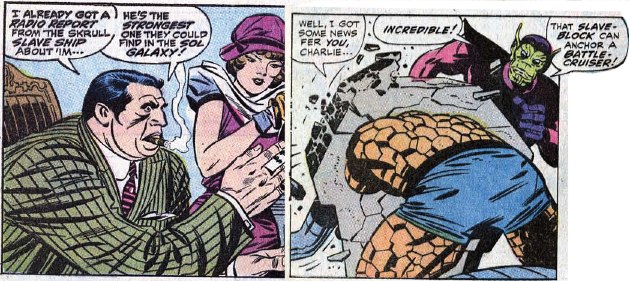
In FF91 Ben is enslaved. Note that the brain blast is
needed to subdue Ben. This is a more extreme version of the
depression that normally saps his strength, and allows us to see
his true strength when the blast is removed. See "how strong is The Thing?" for details.
But when Reed and company come back his depression returns,
conditioned by years of Reed treating him as inferior: hence his
surprise that anybody would want to rescue him. The key to
subduing any person or race is to make them feel worthless. The
contemporary "black power" movement is a reaction to this,
focusing on telling people they are just as beautiful and
intelligent as anybody else.
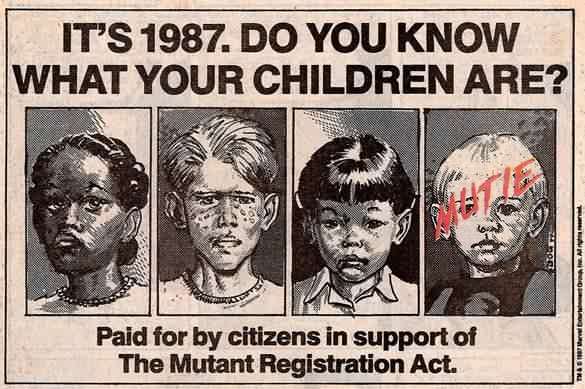
Why is the theme of racism especially important to FF91? Partly because the Skrulls enslave other races, and partly because in Black Panther volume 4 #33 (February 2008), we see that the gangster planet is still there, and is being opposed by an underground movement of freedom loving Skrulls. They model themselves on Malcolm X and Martin Luther King.
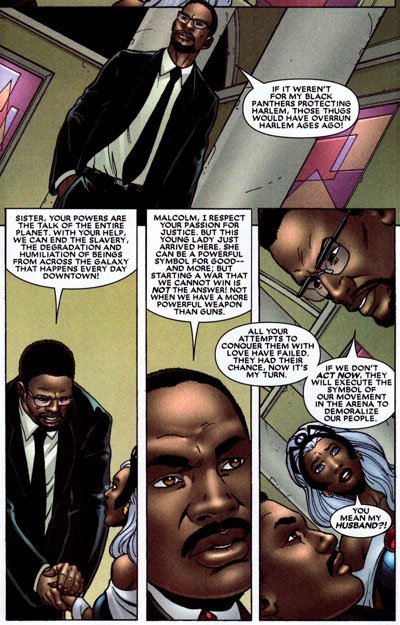
Images and details courtesy of Bully's
amazing blog.
The zeitgeist
Apart from the wider themes of racism, self esteem and slavery,
and the use of 1930s gangster culture (essential for any book that
can claim to be the definitive Great America Novel), the scenario
is clearly modeled on the Start Trek episode "A
Piece of the Action" that aired in January 1968 and was
repeated in August 1968, a few months before Jack Kirby plotting
this issue. It was also based on Star Trek's "The Gamesters of
Triskelion," was a take-off on the 1960 film Spartacus. It
featured Kirk in a restraining collar like the one Ben wears. Why
base a story so clearly on a TV show? Partly it was a good show
and fits the FF's themes, but at this point Kirby deliberately
kept his more original ideas back from the FF. See 1968 for why. Also, “Napoleon G.
Robinson,” has the face of Edward G. Robinson, star of many
gangster movies.
Criticisms (source)
This is the only time we see a Skrull ship with just one occupant. If
gathering slaves, many of whom are super powered, it would be crazy to
send a lone Skrull, so what happened to the other one back in the 1930?
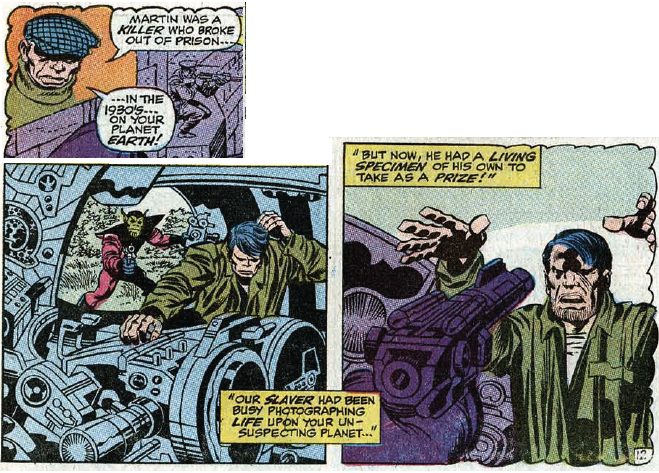
This may be the key to the most audacious fan theory of all: one that explains everything in the Fantastic Four at a single stroke.
A friend started the ball rolling with this wonderful question: "Is this the original telling of the Reed Richards - Sue Storm story? It certainly functions well as such on a symbolic level. Maybe someday Mr Fantastic shall finally turn to dust...."
http://www.dailymotion.com/video/x147nva_long-live-walter-jameson_creation
This really got my mind racing. What if Reed des not age? That would explain a lot... no, wait, that would explain everything.
Endless problems:
So, sharpening Occam's razor to molecular precision, we remove all these intractable problems in one bold movement. Can you guess? Here's a clue: we all know how Reed's face changed drastically, especially over the first three issues. But look closer: it was also changing before the accident. Sure, we can say "artistic license" but my guide is what is actually in the final books.
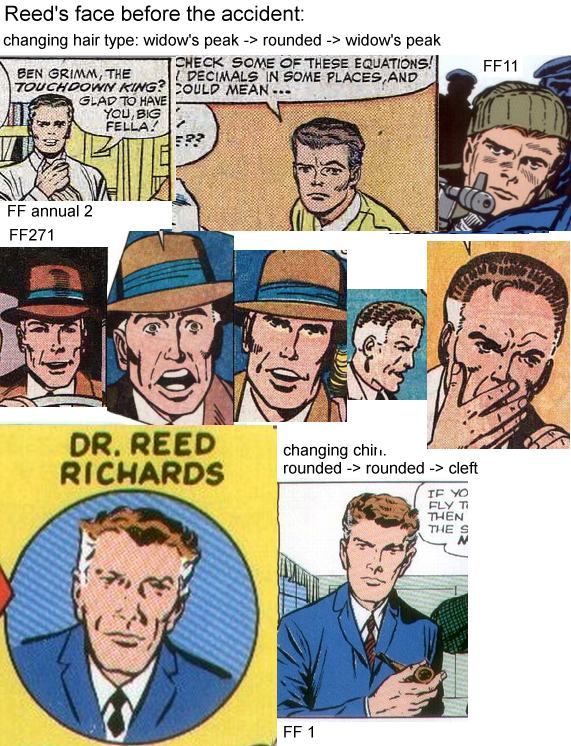
Chin bones and the direction of hair growth are genetic: you can't change those. And look at Reed's body in the Gormuu adventure: compare it to the human bodies next to it. Reed's arms are too wide apart, and no human chin could extend quite that far.
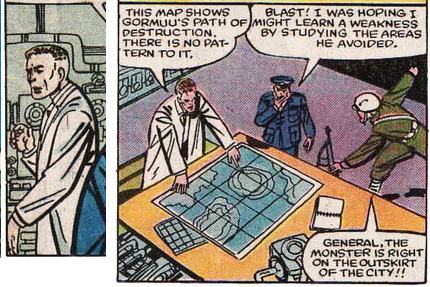
Who do we know who has a large chin and can change their face? Who,
if trying to look human, might occasionally miss details like this? Who
do we know who was visiting Earth in the 1930s, the time of the first
reference to Reed? Who (according to issue 2), "hates being skrulls"?
Whoops, gave it away there. Imagine you were a kind hearted, thoughtful
skrull. You would not fit in, You would not be able to progress, but
would remain a junior soldier. You would hate being sent to kill
and enslave innocent beings. You would be looking for a way to escape.
Your advanced alien knowledge could give you a very comfortable life on
earth, maybe working on Earth rockets. Why not? Sure, you might come
across as cold to your fellow humans, you might seem secretive and
obsessive, but hey, nobody would care if you could deliver the
scientific goods.
This solves everything:
The Great American Novel
Perhaps my favourite part of this theory is that it makes Reed an
immigrant, trying to fit in, and justifies the slight hint of the Statue
of Liberty on the cover (the first thing immigrants would see). Reed is
Marvel's Superman, created by two Jewish kids, an alien hiding in
disguise.
Objection?
But if Reed is Skrull, how does he not lose his powers in annual
19 when all Skrulls are de-powered? But he does!!! After the Skrulls
lose their ability to change, so does Reed! At the end of that story we
do not see Reed stretching. Once back in the space ship home he
stretches his arms, but we know that Red has fake arm stretching
equipment for emergencies like this (see FF 184 for example). Once home
he finds some way to stretch his legs as well (no doubt a variation on
the mechanical arm stretchers), but he does not stretch his body.
Finally, in issue 287, we see Reed spending a great deal of effort
on a very large brainwave scanner. Why such a large one? He has used
much smaller devices before. And why take so many pages of the story to
talk about it? And why does he need a head set when its results are
displayed on a screen? Its ability to scan so many brains from
such a distance, including brains like Doom's that would naturally be well shielded, suggests extremely advanced technology:
something like the hyper wave bomb in annual 19. The hyper wave
bomb must work on very similar principles; detecting and analysing nerve
impulses at a very subtle and sophisticated level. So the brainwave
scanner is exactly the equipment Reed would need to cancel the effect of
the hyper wave bomb for himself. And sure enough, after using it he can stretch normally again.
That's about it. You can tie up the straight-jacket and return me to my cell now.
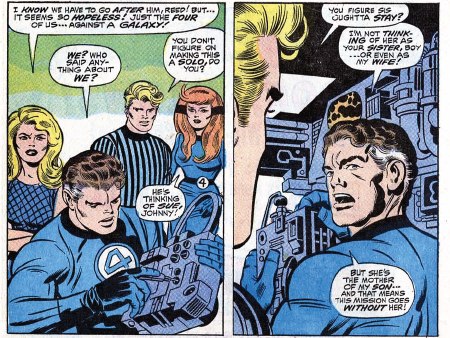
Foreshadowing battle world
Step back and see the big picture of Ben's life: the Skrull world is a
critical experience. Note the numerous parallels with Ben's experience
on Battleworld at the end of act 4:
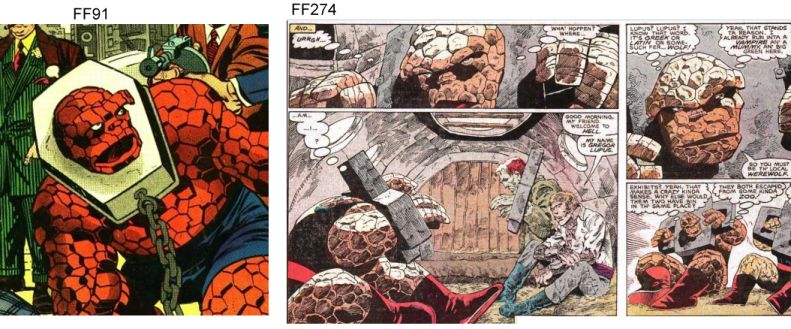
Reedl: the cracks begin to show
This is the issue where we see most clearly the harmful effects
of Reed's ego. He ignores his child, as if Franklin is just Sue's
responsibility. He then sidelines Sue, as if she cannot make her
own decisions. To illustrate how serious this is, we are shown
what Ben can do when he is outside Reed's control. On a foreign
planet Ben's natural confidence returns and he reverts to Hulk
level strength. Ben's strength, and how it is a result of his
confidence, is discussed on Ben's own
page.
The Zeitgeist
This issue illustrates how confidence leads to strength, and arrogance
leads to weakness. These are defining features of modern American
history, as perhaps the most confident and definitely the most
powerful nation on Earth. The crisis between confidence and
arrogance was never more clear than in 1969, when the nation put a
man on the moon yet was entangled in the Vietnam war and civil
unrest, and Richard Nixon (or both China and Watergate fame)
became president.
A family first, super heroes
second
The family continues to evolve and develop. Gradually the
costumed hero era is passing and the focus is moving to the
family. Note the civilian clothes on the Skrull planet : "...a
growing tendency for the FF to be seen out of uniform. Most of the
final Kirby episodes show the foursome in their civilian clothes
for the first half of the story. In other issues, like FF #94, 96
and 97, they don’t bother to suit-up at all. Could it be that Jack
was sick of costumed superheroes at this point? Kirby historian
Mike Gartland opined that since the birth of Franklin, the FF had
become a more 'normal' family. As such, the King was portraying
them in normal attire." - Mark Alexander, "Lee & Kirby: The
Wonder Years"
Note that this natural progression is frustrated by Reed's desire
to control everything: he won't let his family grow. This leads to
years of stagnation and pain in Act 4, leading to eventual
redemption in Act 5.
Criticisms (source)
Hypno glow
"An upfront annoyance is
the whimsical use of science in this issue, to no real good
effect. Ben and the other prisoners are kept in check by a
‘hypno glow’. The term ‘hypno’ is just a catch-all term for
control, it seems, and there’s no evidence of any thought at
all behind how it actually operates. To tag the term ‘glow’
onto it is just silly." Readers will not be surprised
to hear that I disagree. As a way to explain a low level mind
control device that affects every part of the world, "hypno
glow" is perfect.
Sonic disruptor
"The science of [the threat
to planet Earth] is just as laughable. The machine used to
effect a change of the planet’s orbital trajectory is a
sonic disruptor. Would disruption cause a planetary shift?
It’s possible. Would that sonic wave reach across billions
of miles of vacuum? Absolutely impossible. And even a
light-based weapon would take years to reach the nearest
planet, even if it could be targeted accurately." This criticism
forgets FF32. We saw at the end of the "Invincible Man" story
that the Skrulls had a transport ray linking the planets, a
kind of worm hole that avoids the limit of the speed of light.
As for the mechanism of sonic disruption, sound waves are just
vibrations. They imply some physical medium. Clearly the
Skrull device sends some kind of material through the wormhole
in order to batter the planet. "Send it our of orbit" is
probably hyperbole, such as a mobster might use, indicating a
high impact.
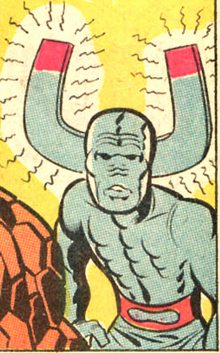
"A substance that is diamagnetic repels a magnetic field. All materials have diamagnetic properties, but the effect is very weak, and is usually overcome by the object's paramagnetic or ferromagnetic properties, which act in the opposite manner. Any material in which the diamagnetic component is strongest will be repelled by a magnet. [...] As water is predominantly diamagnetic, this technique has been used to levitate water droplets and even live animals, such as a grasshopper, frog and a mouse. However, the magnetic fields required for this are very high, typically in the range of 16 teslas, and therefore create significant problems if ferromagnetic materials are nearby." (Wikipedia, magnetic levitation)
Generating a sufficiently high field is the easy part: it's a crude matter of supplying energy. The real skill is in distorting the field away from anything metallic. This explains why the magnet has two separate ends (for directional purposes) and is placed in the head (to minimize the delay in mental processing: neurons use chemical pathways that operate at far below the speed of electric current in, say, wire. So microseconds matter. The magnet guy's brain would have to respond to fields that fluctuate extremely quickly).
Other points to note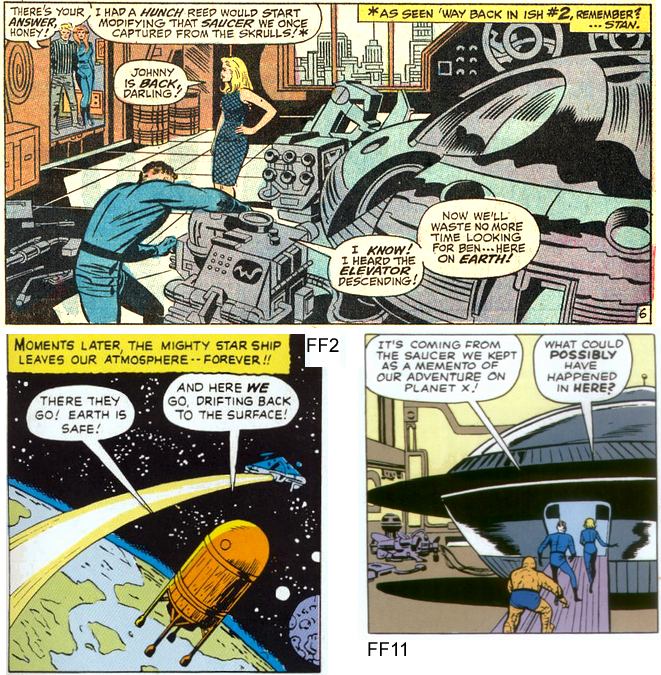
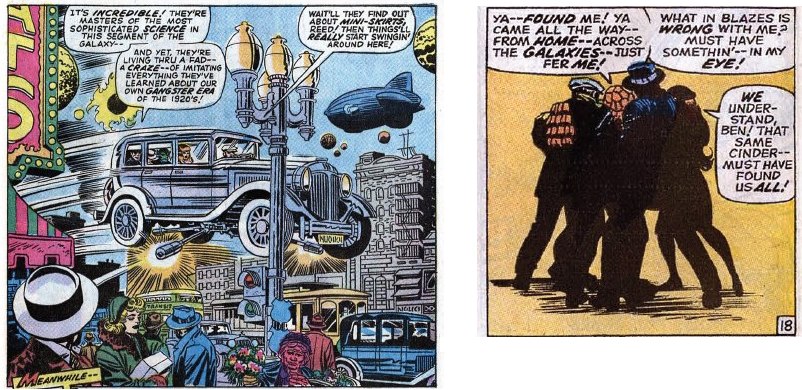
This issue is cover dated December 1969 (although it would be on
sale a few months earlier). It sums up the message of the 1960s
for the Fantastic Four: family. These people would go to the other
side of the universe to protect one of their own. They hug. They
cry. They love each other.
This final 1960s issue prompted general criticisms of 1960s
(Silver Age) Fantastic Four issues: "Because really, all the stereotypes
that typify the comics of the 60s (and this issue is the very
last of that decade) are here: overly verbose and transparent
dialogs, contrived environments and antagonists, and a rather
arbitrary denouement." Let's examine these claims.
Other criticisms of this issue
(source)
Do the team have time to fit into Skrull society before rescuing
Ben? Yes they do. As noted in previous comments, Skrull society is
fast changing. They are used to the very weird. They are also used
to shape changers. If they were not expecting you then pretty much
anything would fit in.
The zeitgeist:
The Great American Novel covers all major periods of history. Lee
and Kirby grew up in this era. For more about the 1930s, and also
the wild west era, see the end of John Byrne's run (the 270s to
290s).
Other points to note:
The missing Watcher sequence
There are rumors that some time in 1969 (or perhaps earlier) Kirby
removed a whole section about the Watcher from the Fantastic Four. It
was around the time that he also removed this gorgeous image:
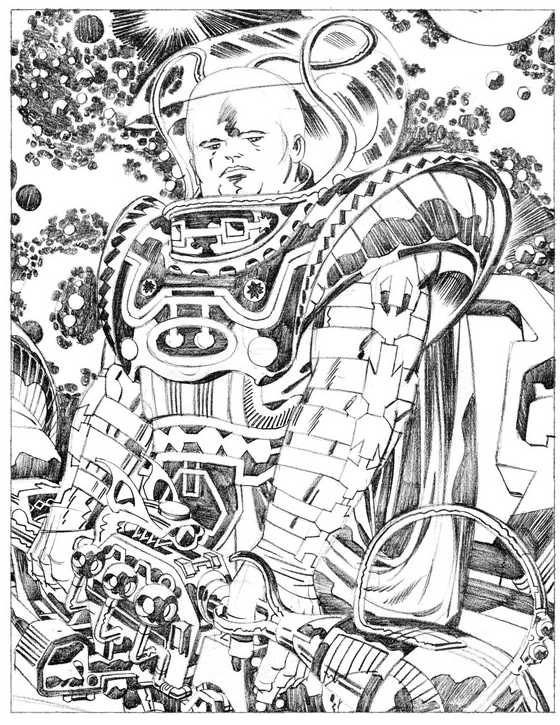
From the Kirby Museum: "This
year [1969]: Kirby withholds full-page splashes from Thor, replacing
them with supposedly lesser pages, presumably at wife Roz’s urging
(“They’re too good for them…”). November
(January 1970 cover date): Kirby withholds original design of Agatha
Harkness for FF #94, as too good for them, as well." A museum visitor asked which Thor pages they were. "Kirk G" replied: "I believe one of them is the full page Watcher in a space suit that has appeared as a solo piece. There’s
also reports that Jack claimed he (had to) remove an entire sequence
from the FF regarding the Watcher and used it over in Thor.
This was probably part of the interrupted Galactus arc, as original
pencils have surfaced that showed altered figures of the Watcher turned
into Galactus. Mark Evanier might have better info on the other
“withheld” pages Roz lobbied him to keep." [emphasis added. The
"interrupted Galactus arc" probably refers to Thor 160 and 168-170,
contemporary with FF 82 and 90-93. When Kirby created Thor 90-93 he had
Galactus come to Earth to help Thor fight the Thermal Man, but Stan got
Jack to change that part and redraw it. No wonder Roz persuaded him not to give Stan his best stuff.]

Franklin's name
In
FF94 Franklin is named. The name Franklin means "Free Man," a name
reminiscent of Paul Atreides (the man who became a messiah figure
in "Dune," published 1965, and "Dune Messiah" in 1969). "Free man"
is in the sense of "territory held without paying dues." Franklin
manipulates whole planets (see Heroes Reborn), and can do anything
he wants, without understanding the price that must be paid (see
for example FF240 where galaxies are like toys to him, or FF245
where Franklin grows up, or annual 24 "Days of Future Present").
Benjamin
means "son of my right hand" meaning heir.
"Richards"
means "hard ruler" -- how suitable for the entire family.
So
his name - "free man, controls without paying the price, heir to
the rulers - is perfect for the being who controls
the universe without
realizing it. Did Stan Lee know what he was doing? Absolutely not:
but he channeled the culture around him, (including name suggestions from readers) and
certain names and situations felt right.
Franklin's life is foreshadowed
Franklin is fated to be ignored by his parents. This will be the
major underlying theme of the story from now on.
As soon as Franklin is named they abandon him to a stranger. Ben is right: the child would be safer with the team. Sue's forcefield, plus her ability to make things invisible, is perfectly designed protection. Sue is held back by Reed, but she will later learn to do more than one at a time.
When he isn't left with Agatha they leave him with blind Alicia (e.g. FF88, FF251). Does Reed secretly want Franklin to be attacked?
Is Agatha Harkness really so good? While she does protect him from the Frightful Four, she also gave him to Annihilus (see FF239-242). Then her own son (Nicholas Scratch) possessed Franklin (FF223)! And the Frightful Four knew about the "safe" house immediately, so it wasn't so safe. They could have been defeated anyway, as Medusa had joined them specifically to help the FF. Plus Crystal would have been there.
Did they have any choice?
Sure, in hindsight we know Franklin is a powerhouse even as a baby, but could Reed have known at the time?
Yes, they knew: Sue's intuition is never wrong, and it says to be
with Franklin. They know that Franklin has cosmic control rod
energy in his blood, so he is worth studying.
But instead Reed doesn't even care enough to give
him a name at first, then gets rid of him at every opportunity.
There are strictly controlled visiting hours and holidays, even
when Sue wants to see him!
Dr... who?
FF94 is about how to raise children. This issue is the heart of
the 28 year conflict: does Reed put his family first?
As a family drama, and the Great American Novel, child-rearing had
to arise sooner or later. Sue's approach, as a stereotypical
mother figure, is to be close to the child (she was shown by his
cradle, holding him, playing with him, etc.) But Reed's approach
is to be distant: to send him away to a nanny. The 1960s was a
time of debate and conflict in this area as in s many others. Sue,
like most mothers, deferred to the father's opinion. But in the
1970s (Act 4) all this will change.
Sue and Reed reflect the great debate over child rearing: Doctor
Spock versus Doctor Watson. Doctor Benjamin Spock "was an American
pediatrician whose book Baby and Child Care, published in 1946, is
one of the biggest best-sellers of all time. Throughout its first
52 years, Baby and Child Care was the second-best-selling book,
next to the Bible. Its message to mothers is that "you know more
than you think you do.'" (-Wikipedia) Doctor John B. Watson was
father of the behaviorist school of psychology. He wrote the book
'Psychological Care of Infant and Child' and argued for minimal
contact between parent and child. As a lone scientist who lacked
Sue's maternal instincts, Reed's views naturally follow Watson.
The power of metaphor
Note the power of comics over any other medium: subtle abstract
ideas become very simple. Instead of saying "the father distances
himself from the child, against the instincts of the mother" we
show the father giving the child to a witch! And in Act 4, instead
of saying "the child is psychologically damaged" we see the witch
betray the child to the embodiment of death, and the farther
shoots the child with a gigantic gun! Nothing does metaphor better
than the FF.
The Doctor Who character Jack Harkness was named after Agatha Harkness. Like Agatha, he seems a pure hearted hero most of the time, but sometimes we wonder where his real loyalties lie.
Other points to note
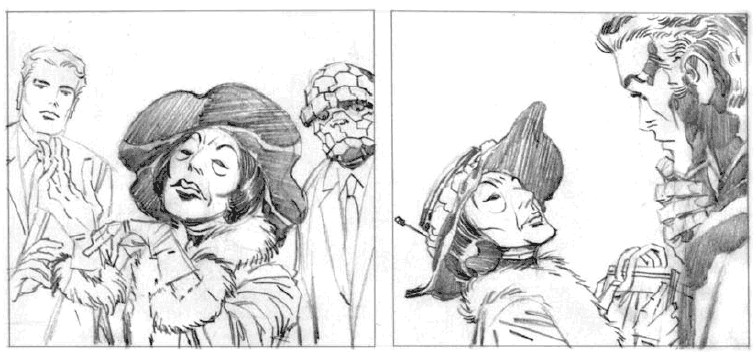
Mark Alexander, in "Lee & Kirby: The Wonder Years" published
those pencils. He said that "some people" think the younger
Harkness looks like Jack Kirby's wife Roz. It is important to note that, according to The Kirby Museum
(see their notes on 1969), Jack probably decided this art was "too
good" for Stan. So he changed the younger, more interesting Agatha and
made her older and more witch like. What do you think?
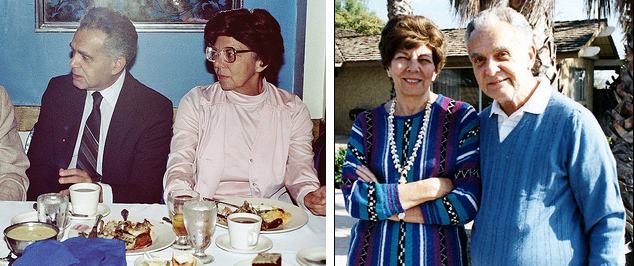

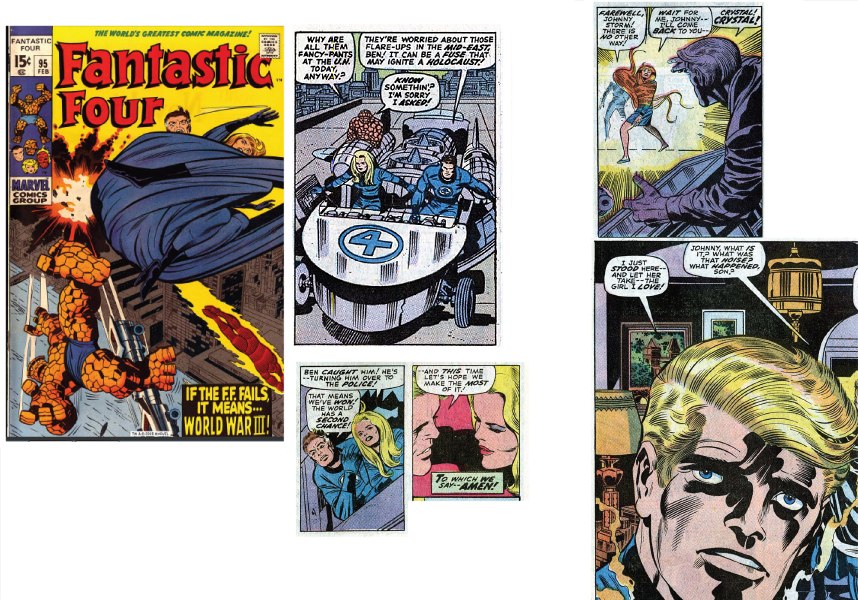
At first glance this story is about how Johnny's conflict of
loyalty lost his true love. This is the central love story of the
28 year epic, and this is one of the defining moments. For the
full story of how Johnny lost Crystal, and how they are fated to
be together one day, click here
This story is also about the late 1960s zeitgeist: cold war spies sabotage the United Nations, almost causing World War Three. it also reflects popular cultural tropes of the time - James Bond, the man from UNCLE, etc.
But really this issue is about Jack Kirby, the man who co-created the Fantastic Four and plotted and drew their golden age.
Jack as The Thing, summed up in
one image
This image from FF95 is sometimes used (correctly) as an example of why Jack Kirby was the king of comics. He's just drawing a building, yet it's beautiful. And also personal, dramatic, etc. At this point (since 1968), Jack was putting less effort into each issue, but still hits the ball; out of the park with pages like this.
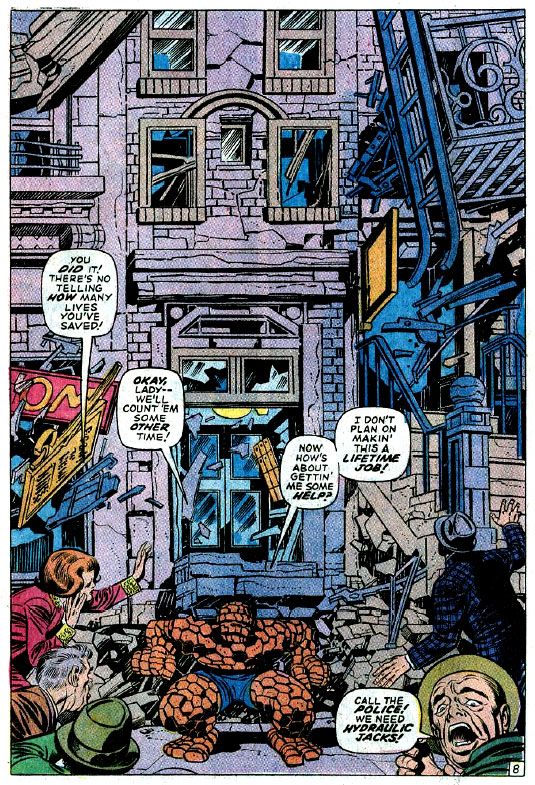
Why is this particular image so good? Because this is a picture
of the kind of run down neighborhood where Jack grew up. And at
this point Jack probably felt like Ben: under intense pressure,
and not planning to make this a lifetime job. Note that Kirby is
often compared to Ben, and played the role in the "What If" story
where the bullpen became the FF. By he time of this story,
1969, Jack had a huge work load, drawing and plotting numerous
books every month. He had been repeatedly promised better pay, but
those promises, mainly from publisher Martin Goodman, were broken
(see the Comics Journal or any Kirby fan site for details). This
is despite Kirby creating billion dollar ideas that Marvel is
still milking for hit movies fifty years later.
The man In the corner says "WE NEED HYDRAULIC JACKS!" As Bully said, "Sorry, Mister, but you only need one Jack: Kirby."
Jack's last issue was FF102.Note also the parallels with Crystal being trapped, and Johnny promising to help her, but ultimately failing her.
Regarding the phrase "king of comics" Johnny
Carson once saw the claim and mocked it, thinking it
referred to an unknown comedian being called the king of stand up
comics. When he learned that "comic" in this case refers to comic
book, and that Kirby's status is universally acknowledged, Carson
apologized. Note that Carson was a major celebrity but his
creations are now consigned to history, whereas Kirby's creations,
thanks to e.g. the Avengers movies, are now more famous than ever.
In Mark Waid's run Jack Kirby's role is summed up: when the team
meet God, God is Jack Kirby.
Other points to note
For the limits to Ben's Strength, click
here.
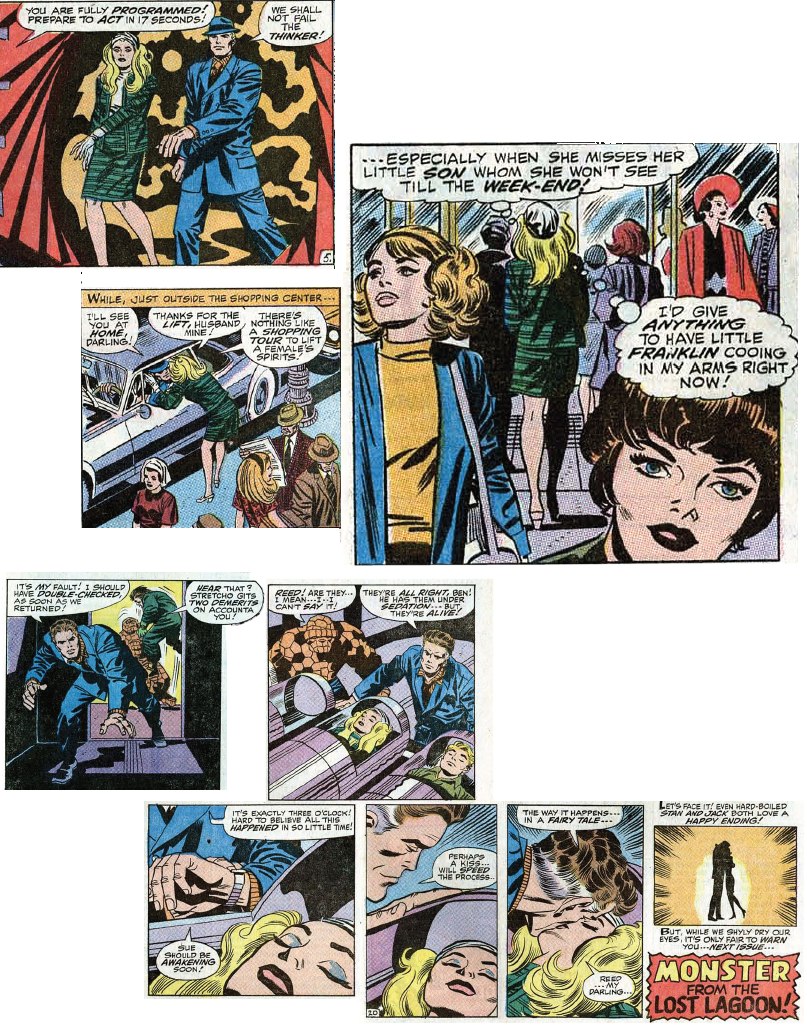
And this story progresses the bigger story by reminding us that,
even as Reed is slipping into a darker place (neglecting his
family and treating adults like children) he still genuinely loves
his wife. Sue of course wants nothing more than to have Franklin
in her arms, but Reed just sent Franklin away to live with a
governess. Note the irony that the forward thinking man of science
has social ideas from the Victorian era.
Stories based on movie genres
This is the Great American Novel and these issues are homages to
America's greatest cultural invention: the movie.
Issues 91-93 combined gangsters, Roman epics and sci-fi.
Issue 94 was horror.
Issue 95 was a cold war spy action thriller.
Issue 96 is film noir
Issue 97 is a 1950s B movie
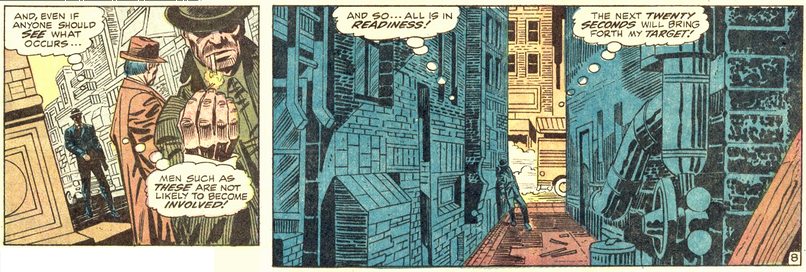
The elements of film noir:
Please remember that Reed Richards is perhaps the greatest human hero ever.
His tragic human flaw must be seen in that context.
Alternate cover:
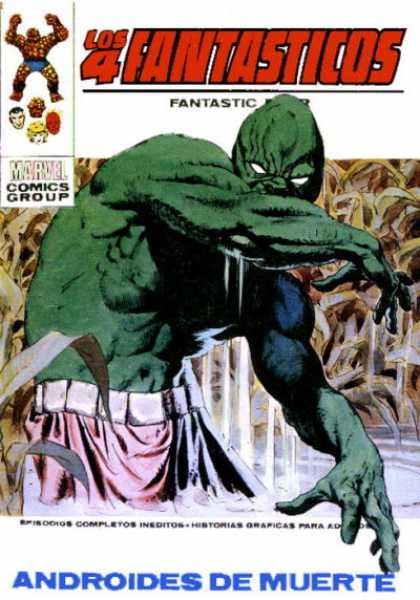
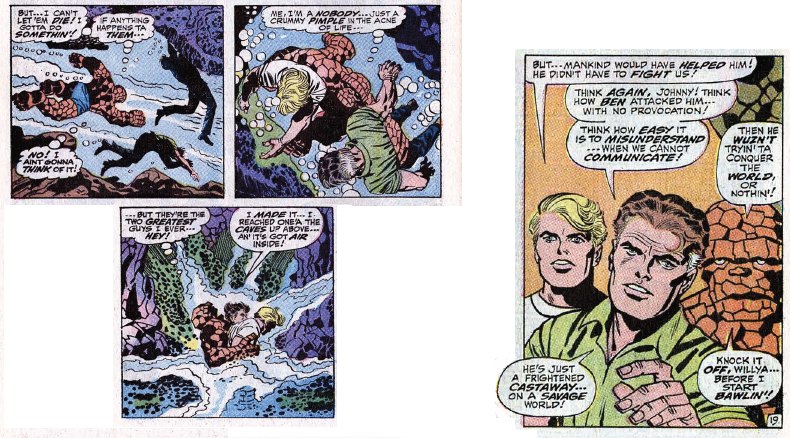
The running theme of this 28 year Great American Novel is Reed's
ego. He needs to feel he is in control, or terrible things will
happen. In contrast, Sue wants to enjoy life, to have peace and
harmony, and to focus on the family. Who is right? Pretty soon (as
Act 4 begins) Reed will find his self imposed work load grows ever
harder until he can no longer cope and everything falls apart. If
we accept Reed's view of the world, one of endless danger and
conflict, it seems that he has no choice. But if we step back and
take the long view, we see that Sue's way is nearly always better.
This issue drives home the point in the most dramatic way
possible: unique among all their conflicts, this one can be solved
by doing precisely nothing: and Reed cannot see it. Sue's
intuition is always right, as Reed himself had admitted, and here
she instinctively knows that they should spend the time on the
beach with Franklin. And that is exactly what she does, while the
boys run off in their testosterone filled way, convinced the world
will end of they don't fix something.
They should have left alone. Sue was right. This can be seen as a
comment on the Vietnam war, and of war and conflict in general.
Reed's idea of a world filled with conflict is an illusion. Sure,
there is conflict here and there, but the solution is
understanding, not mindless fighting. Reed of all people should
know that understanding is the key.
This is a turning point. The increasing use of civilian clothes
and the appearance of Franklin indicates that the team should move
on, and focus on the family. Leave the fighting to the younger
generation as they learn the lessons that can only come from
experience. There will always be battles to fight, we don't have
to manufacture new ones. But Reed, like Don Quixote, has to tilt
at windmills, and he will pay a high price for it.
Criticisms
This issue has been criticized for how long it took the "monster"
to gather water. But we are told that he crash landed, so it would
have taken most of his time to repair the ship. As to why he took
a job instead of spending all his time repairing, he seems to be
like Reed: he's curious. Also like Reed he feels the need to
"protect" his woman, keeping her shut away. If only his woman had
sat on the beach with Sue they could have become friends and
started a new cross planet alliance. Ironically, the male
scientific curiosity led to less
knowledge than they would have gained from just letting the women
chat.
The ever observant Sharon, of "Two Girls,a Guy, and some Comics" noted
that the "monster" looks like Jack Kirby, and this may not be a
coincidence. Contrast John Buscema's taller, more conventional version
two years later.
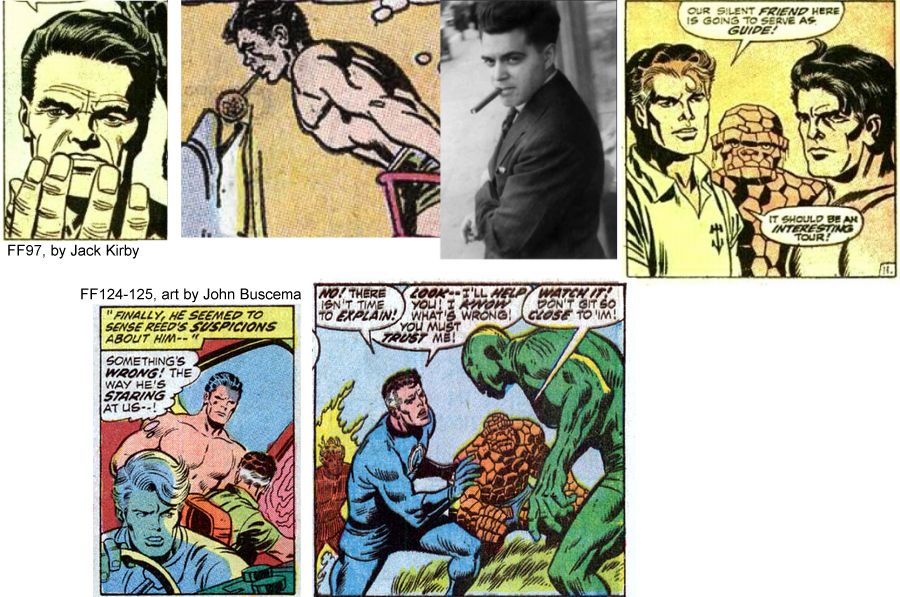
Other points to note
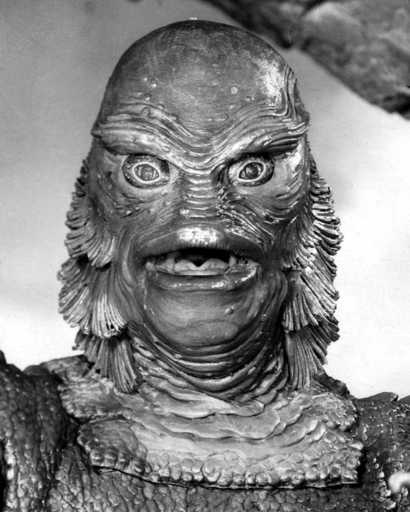
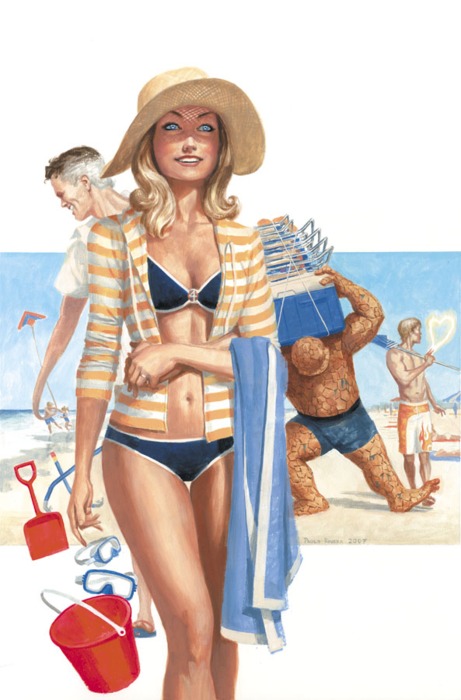
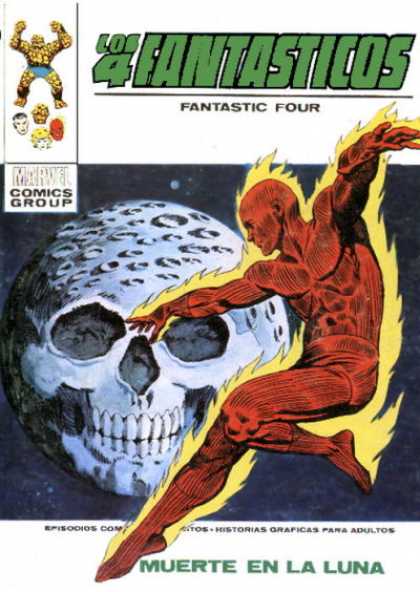
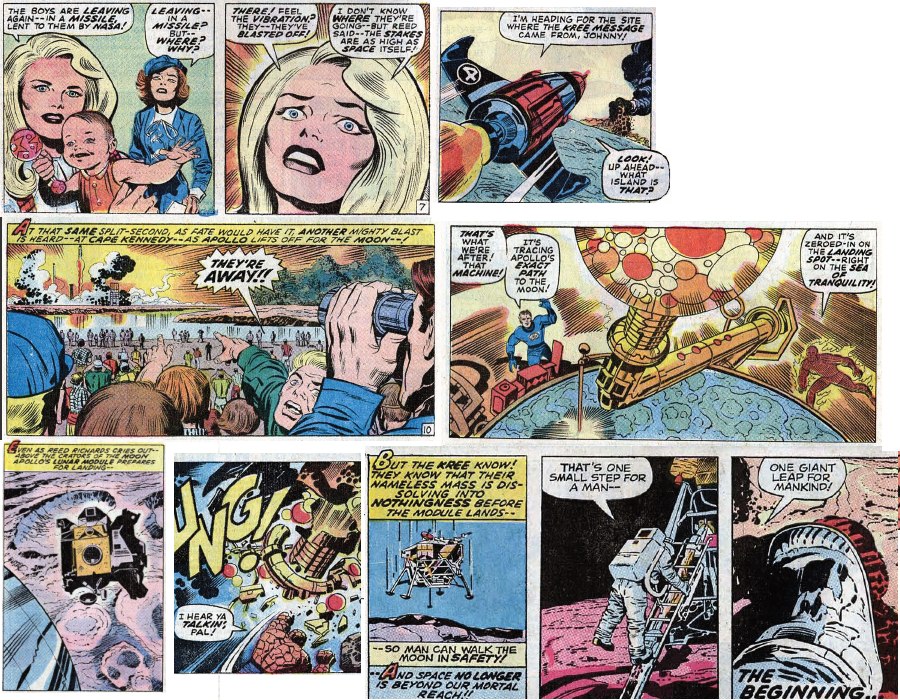
The Fantastic Four began at the height of the space race, and
this is its climax. As the story of America, this is America's
proudest moment: they send a man to the moon.
As regards the ongoing family story, this is where Sue begins to
turn. Reed is metaphorically on the moon: so distant from her. He
ignores her intuition as if it is worthless. Look at her face: she
is losing respect for Reed. After 98 issues of doing things Reed's
way, and oping that he would see her value, she is beginning to
think the unthinkable: maybe this marriage isn't working.
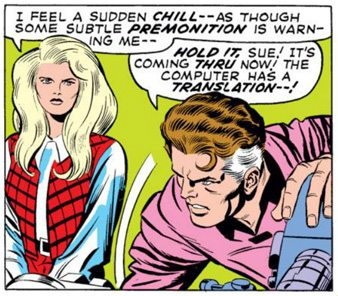
How would events have been different if Reed had listened? They
could have talked about it, instead of going to dinner. He would
have saved vital seconds, seconds that were needed at the climax
to the story. Sue's intuition has never been wrong, and she may
have added crucial insights. Sue was there the last time they
encountered the sentry, she may recognize the clues. But instead
Sue has come to accept that her only role is to make dinner.
The climax issue
This is not just the climax to the space race, it's the climax to
the silent battle between Sue and Reed. For years Reed has treated
Sue as inferior and ignored her, and put the family at risk
because of it. With all his telescopes and instruments he cannot
see what is in front of his face.
Just as Neil Armstrong was unaware of the island that rose from
the sea (water and land: female metaphors; space and science: male
metaphor) what was really going on, so Reed is oblivious to the
seismic changes in his family. After this Sue's obedience will
wane, her resistance will grow, until in Act 4 the strains grow to
great and the family falls apart.
It's not sexism, it's about ego.
This is not about Reed disrespecting women, it's about Reed's
need to treat others as inferior. It's directed at Ben as well.
When Ben triumphantly defeats the sentry ("when ol' Benjy whumps 'em,
they stay whumped! He's
out cold!") Reed tells Ben to stay there in case the sentry wakes
up again (leaving Reed and Johnny to get the glory of the
deactivating the Kree device). Reed then gives his opinion that
the sentry must have been weakened in order for Ben to beat him.
But would the sentry really create a device that weakens itself?
Reed cannot cope with the idea that Ben is as capable as he is. It
is then ironic that Reed has to call for help from Ben, and Ben
saves the day and rescues his comatose buddies. Johnny then
worries that Reed is not strong enough to handle the space ship,
even though Ben is a trained pilot.
Footnote: who were the first men on moon?
This is the first space flight using human technology. Previous contact was due to freak luck. It is like Columbus discovering the New World: plenty of people discovered the new world before that (the people who lived there already, for a start) but the significance of Columbus is that showed it could be done routinely, and so opened the door to everybody else.
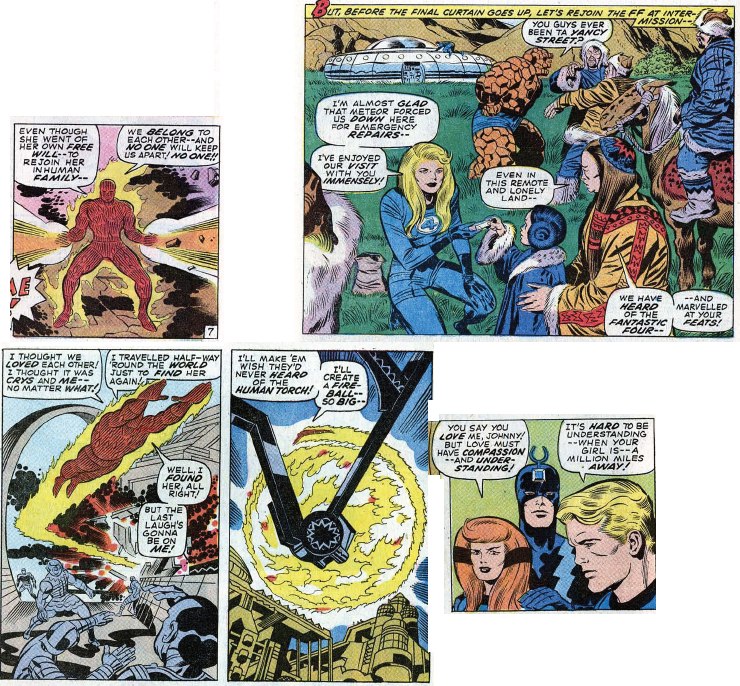
As we come to the end of Act 3, the happy time, we get a glimpse of the next time the family will be truly happy: the next generation, when Sue and Reed spend their time exploring and building alliances, and when the action focuses on Johnny and Crystal. But tragically Johnny is still immature. Like Reed, he sees everything in terms of conflict. He is not ready for Crystal, and his behavior tragically drives her away.
Love
Note that there are no villains in this issue. It is the family
story at its purest: the next generation is struggling to make
difficult choices, with love at the center.
"The emotive force of this one
is quite surprising. Johnny cycles quickly and believably
through a whole spectrum of emotions — frustration,
disappointment, loneliness, loss, anger, surprise, rage,
forgiveness, and, ultimately, love." (source)
Johnny's devotion is prophetic. He would have to wait many years,
but nobody else will ever take Crystal's place: finally they will be together.
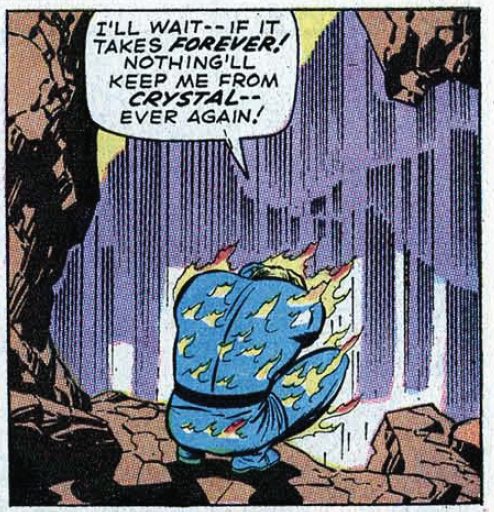
Reed and Sue
We continue to see the rift develop between Sue and Reed wants.
Look at this panel, where the decision is made to follow Johnny.
Some read this panel as Sue agreeing that it is right to look for
Johnny, but that is not what she says. She still wants to spend
the time with Franklin, but Reed overrules her. Look at her
frustration in this panel. She can't take much more of this.
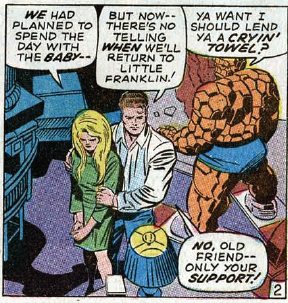
Did Sue want to save him? No. As with the creature of the lost lagoon, this is a problem that is best left alone. The next time that Johnny runs off in anger, in FF129, Sue reveals her own preferred strategy: that time she stops Ben and Reed from chasing the lad. He has to learn some things on his own. His sister knows best.
Did Johnny need saving? No. Although he was angry and could
have harmed people, he was attacking a race of super beings with
advanced technology. As Ben observed, the Inhumans are not in
danger, Johnny is. However, Johnny is pretty tough and the
Crystal loves him, so he won't come to too much harm. He needs to
sort this problem out himself. it's the only way to grow up. but
instead Reed insists that they go and continue to treat him as a
child. because of this, Johnny remains as a child and ends up
losing Crystal.
Note that this is supposed to be the Fantastic four, but three of
the family want to let Johnny alone. Reed is the only one who
wants to follow him, and Reed always gets his way. but not for
much longer.
Criticism (source)
"If Crystal was needed to aid
her brother Black Bolt, why was she simply not told when Medusa
came to find her, instead of being bodily dragged through a
portal? And being there, why did Crystal not send some sort of
message to Johnny in the intervening three issues where the FF
apparently took two vacations? [...] And once before Black Bolt
and demanding answers, why doesn’t anyone just tell him what he
wants to know?" This is one of the marks of realism
in the story. The Inhumans are not a group of Americans, or even
of westerners, or even humans. They are an alien culture. we know
that they have extremely strict class system and that Medusa is
not happy with her sister, considering her too free with her
affection. No doubt the medical need, while genuine, was also a
convenient excuse to teach her a lesson, that the royal family is
in charge. They probably would not let her communicate with
Johnny, and they would certainly not consider justifying
themselves to him.
Note the realistic portrayal of en exotic royal family. In this issue, Black Bolt is revealed to be Crystal’s brother. So Black Bolt is marrying his sister Medusa. Incest is common in small closed societies: it's almost unavoidable when the royal family wish to be separate from the commoners yet their numbers are small. Hence the need for Crystal to enhance the gene pool (see her own page for details).
We see that Johnny is powerful enough to be the natural leader of the FF, when he is able to mature. When sufficiently motivated, Johnny can apparently cover a whole country at high speed, and then with a short rest take another journey of hundred of miles. Presumably he also covered the Atlantic ocean in one go. This is further evidence that the only limits are in his head, and his true power is greater than he thinks. See the page on super science for how this and other powers work.
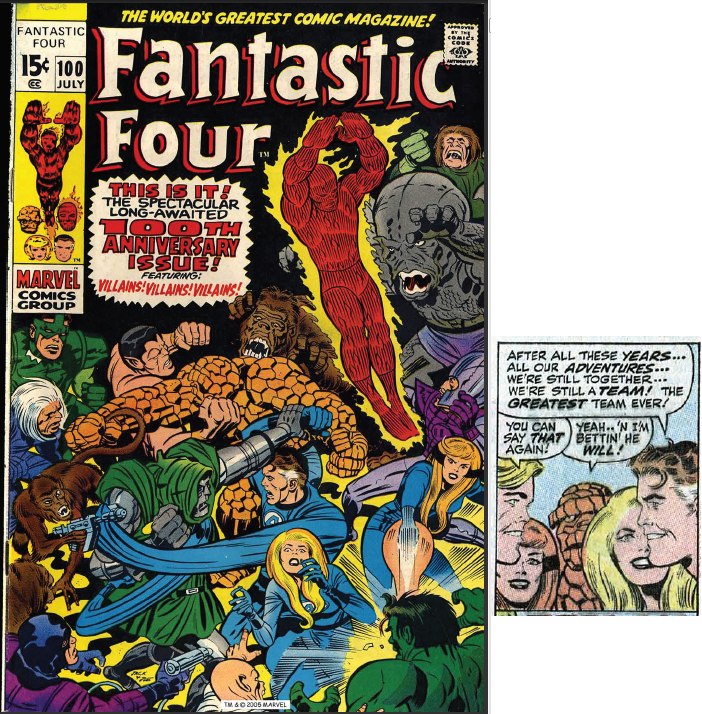
This issue is a journey by many vehicles, a symbol that it's time
to move forward. The big message is that the new team will be in
safe hands: Crystal is more than a match for any danger. From the
first page, when Crystal protects them from a fall, to when
Crystal defeats the hordes of Atlantis, to when Crystal defeats
the Frightful Four (again), it is clear that Reed and Sue can
leave the team in safe hands and concentrate on Franklin now. But
Reed shows no sign of wanting to be with Franklin: he wants to run
the team forever.
Criticisms (source)
"They [the androids] all act exactly like their original counterparts down to their squabbling relations to each other and the exact details of their powers. It begs the question why the Puppet Master and the Mad Thinker went to the trouble to recreate The Trapper’s chemical paste, the Wizard’s anti-gravity discs, the Red Ghost’s intangibility, an absolute mob of Atlanteans, etc., etc., etc." See the page on superhero science for how super powers work, especially the part about how the Thinker's Awesome Android and how unstable molecules imitate what is around them. The simplest way to create an unbeatable army is to create something like the awesome android and duplicate existing characters. This enables them to automatically duplicate everything about the target, including their technology, without the need to understand or recreate that technology piece by piece.
"Why don’t the villains themselves gang together against the FF?" Because the androids are controlled by the Puppet master. It's hard to control more than one android at a time, unless they are a general purpose mob (such as the invading Atlanteans)
"Why do the FF leap to the conclusion of the Puppet Master being the man behind the simulacra when Reed obviously pulls android parts from the ruined Doombot, and not mystical clay?" Because from his very first appearance the Puppet Master has used life-size mechanical puppets as needed: remember the flying horse at the end of FF8?
"Why do they not suspect Doom himself who often uses robot duplicates?" First, because the robots were obviously being controlled. (their behavior is too smart to be entirely self directed). The puppet master is the expert at such control. Second, the puppet master is the master of controlling a variety of different androids, whereas Doom and the Thinker tend to focus on one type at a time.
"Why are the FF so very unconcerned with getting to the root cause of their conflict? For all they know, the Puppet Master is still able and at large." They're too busy merely surviving the constant onslaught. Once the onslaught ends it is obvious that the Puppet Master is powerless, and the team lack the technology (in remote Asia) to track him down.
"Why does the Mad Thinker just apparently follow the Puppet Master around all the time, hands behind his back, like a safety supervisor?" Because that is exactly what he is: he is monitoring and planning to ensure that nothing goes wrong. If only he had done more of that then the Puppet Master might not have made such a mess of the final android.
Other points to note
The story symbolizes human progress. The team begins by landing from the sky on barren rock, like the first human placed here from heaven. They then walk through vegetation and hit rocks. Next they use domesticated animals (camels). The they use boats, recalling the age of exploration and trade. Then they obtain a vintage motor car, and finally they end up in an airplane.
"Mark Evanier told us that FF #100 was originally meant to be an expanded-length Centennial Special, but for some reason the idea got shelved. Consequently, Kirby had to redraw much of the book to fit everything into 20 pages. Hence the story’s choppy pacing and overabundance of 9-panel grids. This explains the page of unused art from FF #100 that depicts the Puppet Master examining the Hulk android on an operating table." - Mark Alexander, "Lee & Kirby: The Wonder Years" In fact, this issue was the first to have one page fewer: just 19 pages due to adding half page ads on two pages. So much in so little space!
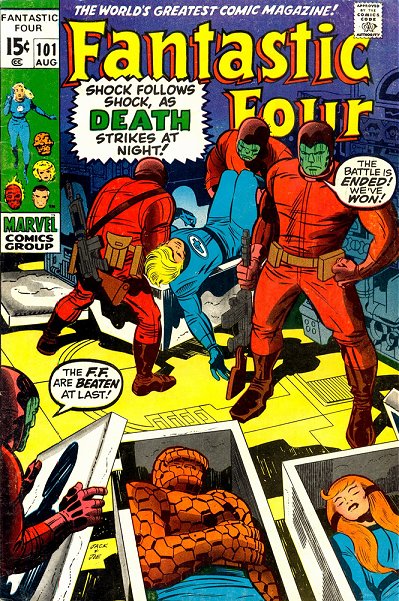
This is Kirby's last cover. The image is powerfully symbolic: many fans consider Kirby's departure as the death of the Fantastic Four. This reflects the end of an era, the end of Act 3. The next story begins ominously and segues into Act 4 and a completely new artist with issue 103, and two decades of decline.
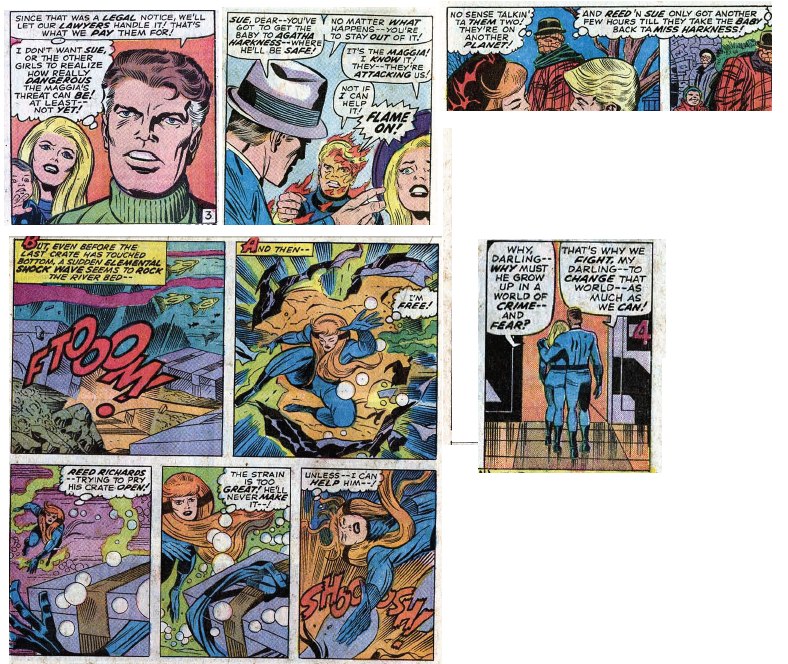
The only people who can defeat a strong family is the family itself.
This is the end of Act 3: the last all-Kirby story. The cover shows the team in coffins, and the statement "the FF are beaten at last." On the surface they are beaten by the Maggia, but they are really no threat: as the Torch says, "any one of us can take you -- with no sweat!" Even if it were a more dangerous foe, like Doom, even if some of the team were beaten, they are never really beaten because another member of the family can rescue them. The only way they can truly be beaten is the family becoming divided. This is what is happening, as Reed continues to drive a wedge between himself and Sue:
The symbolism of the home
This story, of losing their home, is a symbol of losing the family. Reed spends more time on building his house than on building his family. He relies on mechanical defenses, and they never really protect the family. In particular, invaders often enter the heart of the house through the negative zone at the heart of the building. This is a symbol of the negativity at Reeds heart: his need for conflict. He is often trapped in the negative zone, culminating in abandoning his child to Annihilus and descending into his personal hell in FF251. All this time Reed should have paid more attention to the family than the house. Franklin and Sue are powerful enough to repel any invader, if only Reed would let them blossom.
Parallels with the wedding
The title of this issue, "Bedlam in the Baxter building" reminds us of annual 3, the wedding of Sue and Reed, titled "Bedlam at the Baxter Building." Annual 3 parallels FF99-100: in both they fight a horde of bad guys all at once, and it ends with Reed pledging his commitment to Sue. But in annual 3 the bad guys were real and the commitment was real. In FF99-100 the bad guys are fake and the commitment rings hollow. Reed is pledging something that Sue does not want (endless fighting, not love).
Zeitgeist and cultural links "In this story the FF battle
gun totting hoods from 'the Maggia,' which was the Marvel
Universe counterpart to the Mafia. In 1969, the Mafia had become
a household name due to the success of The Godfather by Mario
Puzo. Mario was Stan’s old crony from Magazine Management
Company. In the early 1960s Puzo wrote for Goodman’s men’s
magazines like Swank and Male under the pseudonym 'Mario
Cleri.'" - Mark Alexander, "Lee & Kirby: The Wonder
Years"
Other points to note
Once again, please remember that this site is pro-Reed Richards. His tragic human flaws must be seen in that context.
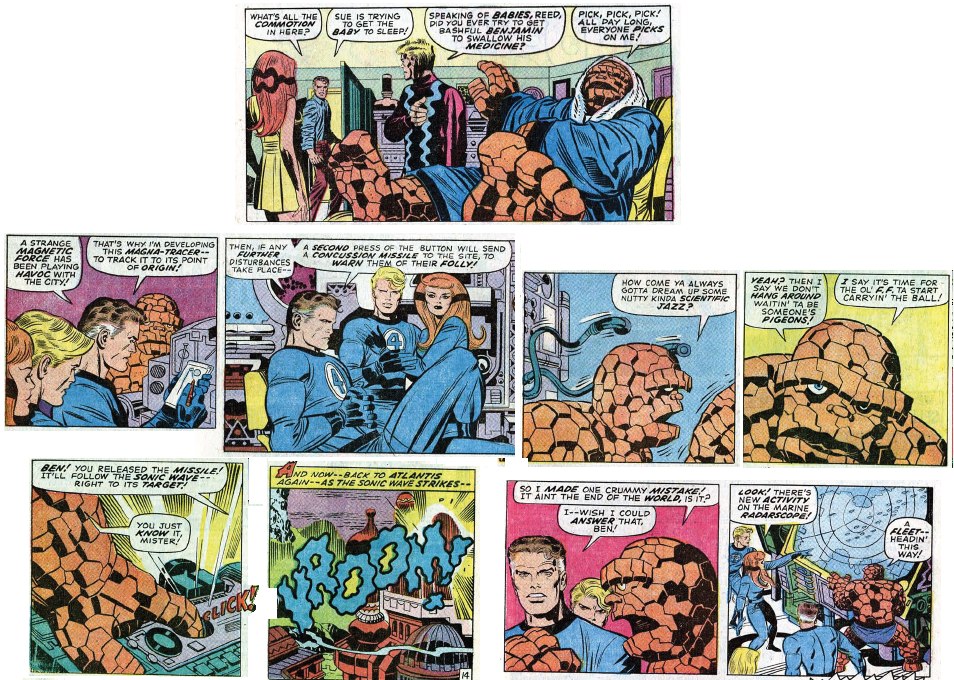
Finally Reed goes too far. It's the end of the happy time The end
of Act 3.
Namor, manipulated by Magneto, once again threatens the surface
world. This parallels the events of Annual 1. Back then, Reed
antagonized Namor so much that he almost caused WWIII. Now he does
it again. In a monumental miscalculation he had a missile armed
and ready, just in case. That was his first mistake, to attack
every problem with violence. His next mistake is to have spent the
previous nine years treating Ben like such an idiot that he now
plays the role. Sure enough, Ben presses the missile button. If
Reed had not destroyed Ben's self esteem years ago then this would
not have happened.
Let us consider what would have happened if Reed was not so rash.
Namor wanted peace and was only persuaded to invade the land
because of Reed's missile. But there is another approach: Sue was
always sympathetic to Namor. She always understood his point of
view. If she had acted as ambassador then the whole
misunderstanding could have been avoided. As for Magneto's power,
we saw on the Skrull world that Ben is strong enough to withstand
any magnetic forces. Sue and Ben could have solved the problem is
not for Reed's ego.
Criticisms (source)
How could Magneto control the wires that attack Ben, when he is
deep under the ocean? Namor has advanced technology, and Magneto
says it can magnify his power. Perhaps he refers to the surface
viewing device used in FF27. Whatever carrier wave it uses can
presumably be used by Magneto, thus extending his reach across the
globe.
This issue is the end of an era. The last consecutive Jack Kirby
issue.

(Technical details: 102 was originally supposed to be a story
about the "The Nega Man" or "Mega Man", and the World War III
story was to be issue 103. But Stan didn't like it, so the Nega
Man story was finally reworked for 108, appearing the same month
as Kirby's first work for DC appeared. Years later the original
FF102 story was reassembled as "the Lost Adventure")
This final story ends by foreshadowing the emotions of the
post-Kirby FF.
